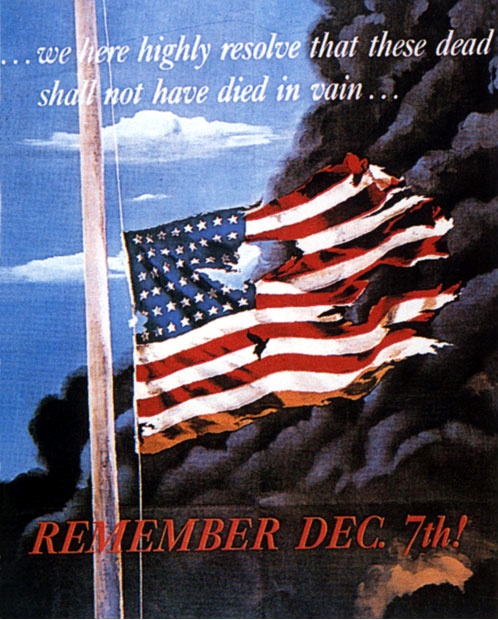February 22, 2012
The Shelf
You may remember that a few days ago,
I had some broadband issues. The powers that be sent a technician to the apartment complex, so as to discover just what was going on. I gather they found nothing out of the ordinary, so the technician came into Pond Central to investigate. When I got home some hours later, there was a note on my door, saying that there was a signal strength issue and the tech needed access to the cable outlet. I groaned at this; the cable outlet is behind a bookcase in my living room... a bookcase overfilled with books. While I knew this was going to be three different levels of hell to deal with, I did realize that I had been presented with a great opportunity. For
years, I've meant to get all

my military history books out of my bedroom and into one of the big bookshelves in the living room... well, here was my chance!
I should have known better. Almost every time there's a broadband connection problem, the techs say there's a signal strength issue. As I was getting the books out of the bookcase, my broadband connection came back. Yay, I guess. Still, I wasn't going to just fill the thing back up again, in case there really was a problem (for once), so I let it sit for the weekend... and the books that had been in it stacked high on my coffee table. While it made watching TV a little difficult (read: impossible), and folding laundry a challenge (read: are you kidding?), I put up with it until Monday.
That night, I came home from the Duck U Bookstore, changed into the grubbiest clothes I had, and began moving books from the bedroom to the living room. Grubby, because some of them were going to be dusty as all get-out. It took an hour, and I still haven't gotten around to organizing them other than by size, but I now have my military history reference library all in one place, where I can easily peruse them. Before this, they were in three different bookcases AND stacked on a dresser in four piles AND stacked on top of two other bookcases. Yeah, this works much better.
The top of the bookcase is devoted to either paperbacks (for example, "
Zero!" by Martin Caidin, though my edition is substantially older than the one linked to, or "
Climax at Midway" by Thaddeus Tuleja, in fact the very edition shown, for which I need to thank Uncle JoeDuck) or quick reference books from
Salamander. Those titles, and the others like it from
B&N Press, are what I term
bathroom reference books, because... well, that should be obvious, shouldn't it? They aren't for in-depth research, but they often provide a good starting point for things that end up on The Pond. Indeed, my post on HMS
Nelson and HMS
Rodney,
The Misfit Battleships, had its genesis exactly that way.
The bottom shelf is full of Tom Clancy, both fiction and non-fiction. They make a good solid weight for the rest of the bookcase. Also down there are two editions of Norman Polmar's "Ships and Aircraft of the US Fleet" (the
14th and
15th, in case you're curious). While I'd kill to have some
Jane's Fighting Ships in here, they're just too expensive (though
this one is reasonable... which makes me wonder why).
In between the top and bottom is the heart and soul of The Pond's Military History category. I haven't quite figured out how I intend to organize them yet... do I alphabetize by author? Arrange by category (with Midway books on top)? By size? By spine color? The world wonders. If you want to take a closer look at The Collection, click on the picture for a much larger version, one where you can actually read the spines.
Having it all in one place for the first time ever is... wow, quite daunting, actually.
Posted by: Wonderduck at
09:54 PM
| Comments (11)
| Add Comment
Post contains 662 words, total size 6 kb.
1
Every time I read about HMS Rodney, I think of Sir Rodney from
Wizard of Id. And then I suppresss a grin.
Posted by: Steven Den Beste at February 22, 2012 10:05 PM (+rSRq)
2
A very nice looking collection indeed. I have my collection overflowing my bookcase and into boxes and onto various shelves. I also notice we have many of the same titles, too.
Looking at that picture is sure fun at figuring out what is in your collection. Paperback copy of Castles of Steel, correct?
I really want to get my hands on Combat Fleets, since I have my doubts about some of Norman Polmar's works and it is comparable to Jane's. But unfortunately, crack is cheaper in this case, and so would be a copy of Blu-Ray set of Kara no Kyoukai Aniplex released last year...
Then there is Garzke and Dulin's Allied Battleships which has sadly not been reprinted since the early 1980s...
C.T.
Posted by: cxt217 at February 22, 2012 10:15 PM (47Cgj)
3
Ack, forgot to re-link to the bigger picture after having to delete the original small picture. Should work now...
CT, no, no
Castles of Steel, though I'm aware of the book. And gold is cheaper than some of the
Jane's Fighting Ships editions.
Steven, now I'm never going to get that connection out of my mind. Thanks so very much.
Posted by: Wonderduck at February 22, 2012 10:41 PM (ZNgWw)
4
Not including any of the Tom Clancy books or the books I have given up on, number of titles in both our libraries is in the double digits.
In retrospect, I should have realize that was a copy of Victory at Sea, and not Castles of Steel.
I also noticed that your copy of Kaigun is sadly missing its dustjacket...
Posted by: cxt217 at February 22, 2012 10:53 PM (47Cgj)
5
I do not understand how a cable connector can be behind a shelf. The socket is small, but the connector and relief slieve stick out quite a bit, and the cable should not be bent hard or else it creates internal reflections, which ruin the signal. I always had to plan shelves a cabinets so that they avoid leaning against cable outlets that are in use.
Posted by: Pete Zaitcev at February 22, 2012 11:19 PM (G2mwb)
6
Pete, the plate is actually behind the bookcase, which is three or four inches away from the wall so as to match with the TV stand.
CT, yeah, I was a little unhappy about the missing jacket m'self, but on the plus side it was only $35. A quick glance at amazon right now shows the cheapest you can get it is for $75. For $40, I'll live without a dustcover.
I'm not surprised there's a lot of overlap between our collections. There aren't many obscure books in mine, and a lot of the "must-haves" (
Shattered Sword,
Fire In The Sky, Frank's
Guadalcanal,
Last Stand of the Tin Can Sailors, etc etc etc...). There's just a LOT of books.
I mean, for a non-professional.
Posted by: Wonderduck at February 23, 2012 12:20 AM (ZNgWw)
7
Do you have "Soldiers of the Sun"? If not, you should.
Posted by: Steven Den Beste at February 23, 2012 12:49 AM (+rSRq)
8
Japan's Imperial Army by Edward Drea is a more recent take on the subject. It is very good and makes for some rather startling revelations.
But how can any collector's shelves be without Japanese Cruisers of the Pacific War? You do need a coffee table to put the book, because if the book falls from any place higher than a coffee table, it might kill someone on the way down.
Sadly, Fire in the Sky is one of those books I am unlikely to touch again. Eric Bergerud's tendency to switch into the first person grated too much, and it happened far too often for a professional work. What is really odd is that Touched With Fire is many ways, a much better written book despite being published earlier by Bergerud.
Posted by: cxt217 at February 23, 2012 09:40 AM (47Cgj)
9
cool collection, seeing Tom Clancy takes me back. I got into Tom Clancy
when I was in 5th grade and this lead me into military history books in
the 6th grade (I'm pretty sure I've read some of books in your
collection) but my local library had so few books of that type that I
quickly had to move into SF which was a much more plentiful (and
cheaper) genre to read.
Posted by: thenullset at February 24, 2012 06:19 PM (88uM9)
10
"I haven't quite figured out how I intend to organize them yet... do I
alphabetize by author? Arrange by category (with Midway books on top)?
By size? By spine color? The world wonders."
I have mine organized by size on shelves like this. That's due to weight, not any "real" organizing scheme. The bottom shelf (and on some units, the middle thru-shelf that splits the side uprights) can hold about half-again more weight. The heavier books always end up there. It's inconvenient, but it still beats overloading the shelves. You can see it in the picture; the second-from-bottom shelf looks like it's got a noticeable sag in the middle, in the gap between
Dogfight and
Artillery. Since the shelves aren't secured along the back, it always makes me nervous when I see that happen in my own bookcases.
Posted by: Ranger Rick at March 03, 2012 02:12 AM (C+SLR)
11
All of the shelves save the bottom one are adjustable on this bookcase, Rick... and the only reason you're not seeing sag on the other shelves is because I flipped them over.
Oddly, the OTHER bookcase, with the manga, DVR, and ducks doesn't have nearly as much warping, despite being at least as heavily loaded.
Posted by: Wonderduck at March 03, 2012 02:20 AM (O9XO8)
Hide Comments
| Add Comment
February 12, 2012
What If...? #5: Opening The Locks
Admiral Osami Nagano walked into the meeting room with an ashen look on his face. Taking his seat at the head of the table, he looked less like the Chief of the Imperial Japanese Navy's General Staff, and more like the weak leader some thought he was. With a shaken tone to his voice, he brought the meeting to order. "Gentlemen, I've been informed that the aircraft carrying Admiral Isoruku Yamamoto on his inspection tour of the Solomon Islands... has been shot down. He is confirmed dead." As the rest of the General Staff reacted to this grim news, he continued. "Admiral Ugaki survived, but is seriously injured." He looked around the table. "Coming so soon on the heels of our losses.. no, let's call them what they are, our defeats, at Midway and that damnable 'Starvation Island', this is another terrible blow. Reports are that the first of the new American aircraft carriers is nearing completion, soon to be followed by a half-dozen more. Gentlemen, unless something is done quickly, the unstoppable tide will soon sweep over us and wash us away. Do any of you have any plans that can balance the ledger sheet in our favor?"
Silence fell over the table. Nagano looked at the assembled General Staff with something approaching horror on his face. "Nothing? Was Yamamoto the only one of us with an imagination?" At that goading, many of the militaristic hardliners flushed angrily but remained quiet. From the far end of the table, a quiet yet confident voice, loud in the nearly silent room, said "There is a plan we have been working on...."
When one thinks of the Imperial Japanese Navy in World War II, one undoubtedly thinks of the aircraft carriers of the
Kido Butai, or the massive battleships
Yamato and
Musashi. More thoughtfully, one might consider the deadly efficient force of cruisers they put to sea or their squadrons of destroyers, considered by many to be the best of the War. Yet only rarely would any consider sparing a thought to the IJN's submarines, unless it was to react in horror to the
kaiten manned torpedoes fielded as a counterpoint to the kamikaze. This is a mistake, as the Japanese submarine force was interestingly varied, not to mention fairly successful in their generally assigned role of warship hunters. Japanese submarines sank as many American fleet carriers (two,
Yorktown and
Wasp) as their conventional naval air did (
Lexington and
Hornet).
On the whole, Japanese submarines were inventive and cleverly designed, if perhaps ill-used. Without a doubt, however, there was one surprising class of submarine where they were the unquestioned best in the world.
more...
Posted by: Wonderduck at
01:00 AM
| Comments (14)
| Add Comment
Post contains 1916 words, total size 14 kb.
Posted by: flatdarkmars at February 12, 2012 01:52 AM (I55Es)
2
If they'd pushed the issue they could have done that attack much sooner, several pre-war classes of their subs carried 1-2 planes. Other, less optimal planes were available, but even the Seiran's first flight was in '43.
As to the admittedly brief respite the blowing of Gatun Dam would have gained them (a year at the very most) a few extra months breathing time before the B-29 raids essentially stopped domestic production could have complicated things for the allies. Historically, a whole slew of advanced fighters as well as several ships including the 16 Unryu class aircraft carriers and a gazillion fast coastal defence subs were halted or delayed when bombers got within range of the home islands, often within a few months ( or weeks) of completion or in the case of the high performance aircraft, just as production was spinning up.
A few extra months of training for the new generation of carrier pilots might have made a great deal of difference at the battle of the Philippine Sea (or whatever took its place).
A few extra months of unmolested Japanese production and aircrew training would not have changed the ultimate outcome of the war, but it could have increased the cost of ataining that outcome out of all proportion to the investment of a few subs and aircrew.
Straying rather further afield, while he canal attack would only work once, assuming that the I-400 program retains its
priority, the I-400s would be coming online in late '43 and early '44.
An attack on New York and possibly Washington using disease bombs could
have caused considerable mayhem. They'd have a better than even chance
of succeeding as the alied ASW effort depended on radio direction
finding and broken codes to track German wolfpacks, none of which would
help against these boats as they'd be not be using German codebooks and
wouldn't need to transmit since the knew where their target was.
Posted by: brickmuppet at February 12, 2012 02:24 PM (EJaOX)
3
Actually, the planners of the construction of the Panama Canal had envisioned a situation where the Gatun Locks or any of the other locks would breached (In the unlikely event of a ship managing to be so out of control that they managed to smashed through all the other safeguards.). They built an ultimate failsafe for it - portable dams for just that eventuality, to prevent the loss of too much water. So draining Gatun Lake was never going to happen if they simply attacked the locks. Hitting the dam would have been more worthwhile, but the dam might have been easier to fix. Knocking the locks out of action would still be worth it.
Of course, by 1942, the US Navy was already planning to send to sea ships larger than the canal could handle, so ultimately, it would not have meant as much either.
As for using the I-400 - you wonder if the Japanese would have been through enough not use their radio communications at any part...
Posted by: cxt217 at February 12, 2012 04:05 PM (k9NA7)
4
@Muppet: I left the date undefined because I couldn't quite figure out the minimum construction time required for an
I-400 class sub. In my brain, the attack in the post took place in early-to-mid '44.
@cxt: I didn't know about the portable dams, and haven't seen any reference to them in my research... interesting stuff, that. I will note that while the Navy had plans to put Panamax-plus ships to sea, ultimately they didn't in WWII.
Posted by: Wonderduck at February 12, 2012 05:43 PM (K/dx0)
5
The MONTANA class got cancelled but I believed MIDWAY herself went to sea before the end of war. If the war had lasted any longer, MIDWAY would have been sent on the long way around to join the Pacific Fleet.
Posted by: cxt217 at February 12, 2012 06:30 PM (k9NA7)
6
USS
Midway: commissioned 9/10/1945.
"...ultimately they didn't in WWII."
Posted by: Wonderduck at February 12, 2012 06:51 PM (K/dx0)
7
There was a nontrivial amount of shipbuilding, including warships, on the US West Coast, which wouldn't have been affected by damage to the Canal.
Quite a lot of it was intended for the European theater, but if the Canal had been taken out, they could have shuffled things around.
Also, by mid 1944 the US Navy in the Pacific was already large enough to win the war. Additional forces made that easier, but Nimitz could have won it anyway.
Posted by: Steven Den Beste at February 12, 2012 07:23 PM (+rSRq)
8
The West Coast did have a lot of shipbuilding - Henry Kaiser and Marinship comes to mind - but warship construction was pretty much dominated by the East Coast yards. The largest warships built on the West Coast during WW2 were the four OAKLAND class CLs. Every other cruiser, battleship, light and fleet carriers, were all built on the East Coast. So were most of the destroyers.
Nimitz and PACFLT probably had enough warships to defeat the Japanese, but the operational strain would have been immense.
I do wonder how much of MIDWAY's completion was slowed down by the imminent end of the war. The US Navy was already cancelling ships from March 1945 on.
Posted by: cxt217 at February 12, 2012 08:30 PM (k9NA7)
9
There's one big shadow over the end of the war which renders most of these kinds of what-if's moot. For instance, when people talk about, "What if the Normandy Invasion had failed" or "What if the Battle of the Bulge had turned out to be a German victory", the answer to all those questions is the same: the first A-bomb would have been dropped on Berlin, and the war in Europe would have ended in early August 1945.
By the same token, these what-if's about the Pacific all have the same answer: The war ends in early August 1945 no matter what happens before that.
If, for instance, the Japanese somehow managed to preven the Americans from taking Guam and Saipan, then the B-29's carrying the bomb would have flown from western China. But they still would have flown, and the bombs still would have been dropped, and the war would still have ended.
Posted by: Steven Den Beste at February 12, 2012 08:51 PM (+rSRq)
10
Way back in my original "What If...?" post, in the beginning of 2008, you proposed (
in a reaction post of your own) that the bombs would have been flown from China, Steven. I'll
repeat what I said back then here:
Not a chance. The chance that the plane carrying the bomb would have a
malfunction and crash-land someplace the Japanese could get their hands
on it wouldn't be taken under ANY circumstances. We barely let our friends
know what was going on with the bomb, after all. The flight from
Tinian, on the other hand, was completely over water... perfect for
jettisoning the bomb where nobody untoward could get their hands on it.
The
logistical problems with flying B-29s from China are well-documented as
well. Throw in the added headaches of trying to get the various pieces
of the bomb to the Chinese base, and it seems even less likely.
Posted by: Wonderduck at February 12, 2012 09:57 PM (K/dx0)
11
I think you underestimate the issues Truman was facing by that point. The American people were tired of war. They wanted it over with. The only alternative was the November invasion, which was estimated to be profoundly bloody and difficult.
I think Truman would have ordered them to do it anyway, irrespective of the objections you raise.
Posted by: Steven Den Beste at February 12, 2012 10:14 PM (+rSRq)
12
You forget the third alternative, blockade. Much less costly than invasion, at least for the US, and they'd be able to discharge a rather large amount of men to boot. The Navy backed the plan, and it's pretty clear it would have worked very well by that time. Japan would have starved to death, but that would have been a minor consideration by then.
I don't doubt that the bombs would have been dropped; just not from China.
Posted by: Wonderduck at February 12, 2012 11:37 PM (K/dx0)
13
When I suggest the war might have continued longer or been more costly, it only would have been so until bases in B-29 range could be secured. If the IJN and IJA had upgraded their air forces in the interim then there would have been a reduction operation until their air forces had been culled sufficiently to allow the atomic bombs to be delivered.
Unlikely that the war lasts past early to mid '46. Even if something like
Hatanaka's gambit had succeeded, we would see operation Downfall, which in its post trinity version involved the use of 14 nukes. I can't see it going on past mid '46.
Note too that if the war goes much past August '45 AT ALL, then MILLIONS of Japanese start starving. One of the things the Allies discovered when they landed was that Japan was essentially out of food, the US and Commonwealth navies spent the winter shipping food in.
I agree with Wonderduck that nukes from China is a non starter. The nationalists were actually backed and trained by the U.S.S.R. and the other force in China was the Maoists. We were NOT going to send our super secret weapon there to be handed over to Stalin (we had our own academics to take care of that).
Posted by: brickmuppet at February 13, 2012 12:34 AM (EJaOX)
14
American war-wariness was a major concern for Truman and officials within his administration - which is incidentally one of, though not the only, reasons for unconditional surrender - but nothing I have read about and from Harry Truman supports the proposition that he would launch the nuclear-equipped B-29s from China or any place where the bomb would not have absolute security because of domestic considerations. FDR might have considered it (Though even he was not likely to approve it.), but not Truman. There was a better chance of the USAAF perfecting in-flight refueling to allow a longer-range B-29 flight than a China base scenario.
That the Japanese was running out of food would have shorten the war, but since the Japanese military and government had made it clear they would let millions of Japanese civilians starve to insure the military remained fed, I doubt it would have shortened the war too much. Lack of materials to fight the war would have done much more to shorten to war, but not that much sooner, even with a full scale blockade being launched.
One thing which becomes clear is that Japan was really fortunate they surrendered when they did. Even a delay of a few more months would have seen XXI Bomber Command focus B-29 attacks on the Japanese rail system while maintaining their mining operations. If the former had happened, it would have crippled the Japanese rail system, which meant millions of Japanese would have starved even AFTER surrender because the distribution system had been wrecked.
This is the irony when people base their arguments against the use of the atomic bomb on the USSBS, which assumed the USAAF kept pounding Japan with B-29 raids. Dying of starvation is no less pleasant than dying from nuclear attack.
Posted by: cxt217 at February 13, 2012 05:27 PM (k9NA7)
Hide Comments
| Add Comment
February 04, 2012
Name This Mystery Ship XII
Might be a fun one this time... or it might be ridiculously easy. It'll be one of the two, for sure.
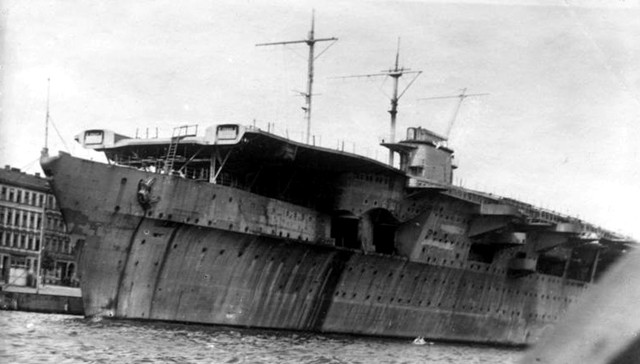
Usual rules apply: no Imagesearch or anything like that. I can't do anything about it, but your victory will be tainted and hagridden. If you DO win, you get a post on a topic of your choice! While I don't do politics, religion or pr0n (other than F1 Pr0n), anything else is fair game.
So get your guessin' shoes on!
Posted by: Wonderduck at
08:44 PM
| Comments (8)
| Add Comment
Post contains 86 words, total size 1 kb.
1
It has a stack like the Lexington CV-2 but the Lexington had a closed bow.
There goes my guess.
Posted by: jon spencer at February 04, 2012 09:35 PM (hFoyt)
2
I'm afraid you're going to suffer a blues explosion. The
Lexington is an incorrect guess.
Posted by: Wonderduck at February 04, 2012 10:26 PM (DxepM)
3
Graff Zeppelin.
The casemates and the oddball catapults are the giveaway.
Posted by: brickmuppet at February 04, 2012 10:33 PM (EJaOX)
4
Very good, Muppet. A winner is you.
Posted by: Wonderduck at February 04, 2012 11:37 PM (DxepM)
5
Time for a naval "what if?" I've read that the Nazi long range plan was to start WW II in 1943, by which time they would have a "balanced fleet", including at least one aircraft carrier. They had already built and were testing aircraft for it, including a carrier-based version of the Ju87 Stuka.
My questions is, assuming that their plans worked out, and the second World War started in 1943 at a time and stiuation of their choosing, what would they use their aircract carrier for? I don't think anyone would consider using a carrier to support an invasion across the narrow English channel, and they expected a quick war where interdicting convoys would not be a factor, so what did they plan on doing with it?
Posted by: Siergen at February 05, 2012 12:40 PM (3/gGt)
6
Remember the Bismarck? Think that would have gone the same if Bismarck had been accompanied by a carrier?
Germany's naval problem was that all their major ports were bottled up. They could build big ships, but they couldn't get them out into the open sea to fight with them.
A blue water fleet with carrier air support could have done something about Gibralter, for example. (Or at least tried.)
Posted by: Steven Den Beste at February 05, 2012 02:25 PM (+rSRq)
7
There were three strategic constrictions between the German ship-building ports on the Baltic and the open ocean. Denmark was the first, but that could be solved by land invasion.
The second was the section of sea between Scotland and Norway. The third was the line between Scotland and Greenland.
Bismarck actually made it past all three of them, but only by shedding all its escorts and proceeding alone.
...and it would have made it, had it not been spotted by a PBY, and then attacked at long range by English carrier-based biplanes. A German carrier would have made all the difference.
Posted by: Steven Den Beste at February 05, 2012 02:29 PM (+rSRq)
8
No guarantees the fighters from a German carrier would have shot down the PBY before it made its report (Even the Kido Butai did not have that much success doing so.) and considering the weather conditions in the fatal torpedo attack, it would have been doubtful any fighters would have made it into the air. Of course, Goering did all he could to insure German naval aviation was stillborn - flying an ME 109 in the North Atlantic sounds positively insane.
Germany could have completed the Graf Zeppelin and maybe the Z Plan as well, but what would they have given up to free the materials for it? Germany faced major resource and industrial shortages even before the war, far more than most people realize, and the Kriegsmarine usually ended up at the back of the bus since its was less important than the Army or influential as the Luftwaffe. Even the projected date of 1945 would not have been possible, given the competing demands - it is implied that the first of the H-class battleships would have not been completed until 1946, even if their construction had not been postponed/cancelled by the war.
Of course, that also ignores what the other nations would be doing. Nothing would be unsettling to a German crew than to break out into the Atlantic during 1944, only to find Lion and Temeraire and maybe a sister or four waiting for them.
Posted by: cxt217 at February 05, 2012 03:00 PM (DkLfO)
Hide Comments
| Add Comment
January 29, 2012
Name This Mystery Ship XI
Well,
this is a fine kettle of fish. I received an e-mail this afternoon from the Official First Friend of The Pond, Vaucaunson's Duck. Attached was a challenge: "Name This Mystery Ship." After working on it for an hour or so, I gave up. And now it's your turn... and I don't know the answer!
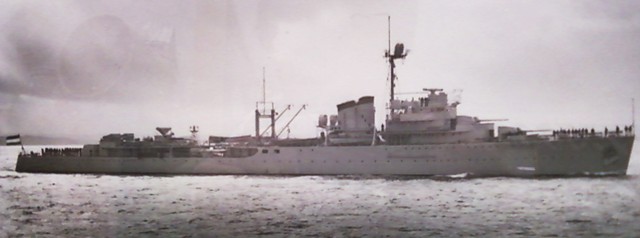
My guess is that it's a destroyer, destroyer escort, or frigate. The flag looks Dutch, but my searching didn't turn up a match of any sort. I guess it could be a cruiser, but it seems like the armament is awfully light for that.
Name the ship and if Vauc can verify that your guess is correct, you win a post on a topic of your choice! As usual, I won't write about politics, religion or pr0n... anything else is free game. Have at it, y'all!
Posted by: Wonderduck at
06:29 PM
| Comments (11)
| Add Comment
Post contains 146 words, total size 1 kb.
Posted by: flatdarkmars at January 30, 2012 12:26 AM (I55Es)
2
flatdarkmars is right.
For some time, I've been looking for a ship photo with the idea of stumping Wonderduck. I figured the photo had to be from an off-line source - so I was pleased to find this photo, framed in an antiques store. I initially thought it wasn't online anywhere, but was wrong about that.
Just six hours from posting to solving - the power of the hive mind.
"The ghost ship." Now why wasn't there a counter for it in Victory in the Pacific, like the De Ruyter?.
Posted by: V. Duck at January 30, 2012 10:39 AM (XVJDy)
3
Apparently I was the only person who didn't know that this was the Tromp. I have an e-mail from Siergen who named it correctly, but admitted to imagesearching for it. I received a textmessage from Brickmuppet two minutes before FDM posted his comment, naming the Tromp.
However, since FDM was the first to leave his guess in the comments, he gets the "prize." Name your post... or should I assume you want another "Name This Mystery Ship"?
Posted by: Wonderduck at January 30, 2012 01:12 PM (OS+Cr)
4
If you think the Tromp was lightly armed for a cruiser, you might want to take a look at HMS Delhi following her 1941 refit in the US, or the Capitani Romani class as built. Heck, Tromp's sister might even qualify.
C.T.
Posted by: cxt217 at January 30, 2012 07:03 PM (JMzrv)
5
CXT, I still owe you a post... you need to get me a topic, though.
Posted by: Wonderduck at January 30, 2012 07:31 PM (f/6aJ)
6
Sorry about that. The last couple months had been hectic, not to mention physically demanding that I had completely forgotten about it.
Posted by: cxt217 at January 30, 2012 08:38 PM (JMzrv)
7
Hehe I spent
at least two minutes finding links!

Anyway I can't think of anything in particular, so another Mystery Ship it is!
Posted by: flatdarkmars at January 31, 2012 12:04 AM (I55Es)
8
what happen to old ship. please, anybody explain to me what happen to any old ship. it is not like an airplane where it's would be easy to sell to other country when it get old
.
Posted by: justjoe at April 18, 2012 06:57 AM (N80Xh)
9
A lot of them do get sold. An American WWII light cruiser was sold to Argentina, who renamed it "General Belgrano". It was sunk by a British submarine during the Falklands war.
But if they can't be sold, usually they're torn apart so the steel can be recycled. Thousands of tons of scrap steel is worth quite a lot.
Sometimes they are ditched in a ship's graveyard, left at anchor to rust away.
Some get taken out to sea and deliberately sunk with scuttling charges. Sometimes this is done to create attractions for scuba divers, in service of the tourist industry. Sometimes they do it in hopes of starting coral reefs.
A few are turned into floating museums.
Posted by: Steven Den Beste at April 18, 2012 09:06 AM (+rSRq)
10
Sadly, being recycled for razor blades will be the fate of USS ENTERPRISE (CVN-65). As much anyone would like to preserver her as a museum ship, the cost and effort involved in removing 8(!) nuclear reactors will leave the ENTERPRISE suitable for nothing else when she decommissions after her current deployment.
I do like the idea of trying to save her island, since that is the most iconic and identifiable part of her. It is a lot easier than saving the entire ship.
Posted by: cxt217 at April 18, 2012 10:34 AM (Y/p7u)
11
Tearing apart any CVN will be challenging. But lifting the reactors out will be a lot easier if all the decking above the reactor is removed first.
Posted by: Steven Den Beste at April 18, 2012 01:19 PM (+rSRq)
Hide Comments
| Add Comment
January 03, 2012
Combustable Vulnerable Expendable 79
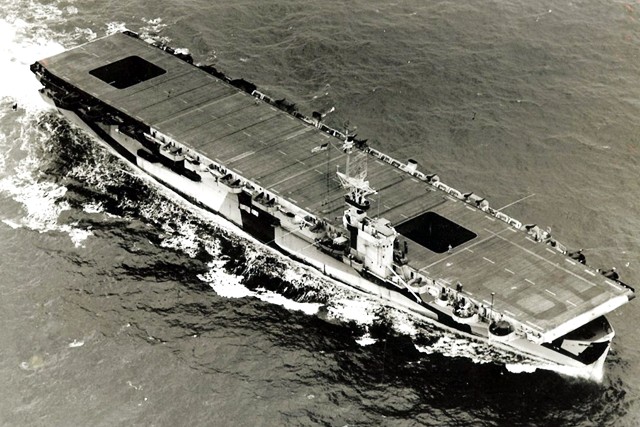
The USS
Ommaney Bay (CVE-79) was the twenty-fifth of the fifty
Casablanca-class escort carrier built. Constructed in just over two months by the Kaiser Company shipyard in Vancouver, WA, she weighed in at just over 10000 tons at full load. At full steam, she could move her crew of 860 men and the embarked "composite wing" of 28 planes at 19kts. Like most other escort carriers, she wasn't designed to fight with the fleet. Instead, CVEs were to be used first as stopgaps, then when bigger carriers became available, to free up the more capable CVs and CVLs to hunt for bigger targets. In effect, the CVE became a air support unit, providing air cover for amphibious landings. It was in this role that she was off Leyte as part of Taffy 2 when Admiral Kurita's fleet famously attacked Taffy 3. Ommaney Bay helped sink one of the Japanese cruisers and aided in the defeat of the larger Japanese force. And it was in the air support role that the
Ommaney Bay was going to serve as she transited the Sulu Sea.
Then the kamikazes came.
more...
Posted by: Wonderduck at
08:37 PM
| Comments (15)
| Add Comment
Post contains 567 words, total size 4 kb.
1
Hmm. I never thought about a local shipyard having contributed to the WWII Pacific fleet... to the Wikipedia!
Posted by: GreyDuck at January 03, 2012 10:35 PM (eHm8o)
2
The three Kaiser yards in the Columbia River area weren't the big ones in the company (the four SF yards held that honor), but they still could crank out the ships... at least "smaller" ones.
Posted by: Wonderduck at January 03, 2012 11:09 PM (f/6aJ)
3
A family friend served on the
Guadalcanal. I've never had much of an opportunity to talk to him about it, but he let me look through his "cruise book", and asked me to restore the print of the carrier on the cover.
Posted by: Ben at January 04, 2012 09:11 AM (RalIr)
4
IIRC Kaiser also had shipyards at Swan Island in the Willamette in Portland. (Which is misnamed because it isn't really an island.)
Posted by: Steven Den Beste at January 04, 2012 10:10 AM (+rSRq)
5
Well, that was kind of the point of escort carriers. If we insisted on fleet-carrier quality, then we'd get fleet carriers... but only a handful of them, which would generally be elsewhere (and require a screen of their own, of course). Escort carriers were cheap enough that you could afford to park them with the transports while the invasion came along... or lose half a dozen and not significantly change the strategic outlook of the war.
So the question is, what would a modern CVE look like? Converted merchant ship with a drone payload? Build enough of those and things could get scary...
Posted by: Avatar_exADV at January 04, 2012 11:55 PM (pWQz4)
6
A modern CVE would be a helicopter carrier.
Posted by: Steven Den Beste at January 05, 2012 12:49 AM (+rSRq)
7
More along the lines of a modified
Atlantic Conveyor, if we follow the original RN's original concept for escort carriers.
Posted by: cxt217 at January 05, 2012 06:04 PM (f81z8)
8
Considering the fate of the
Atlantic Conveyor, that's not a happy thought.
Posted by: Avatar_exADV at January 06, 2012 12:53 AM (GJQTS)
9
The fate of the
Atlantic Conveyor wasn't that dissimilar from that of the
Ommaney Bay. Maybe it's a better comparison than we think (and I think it's a pretty good one).
Posted by: Wonderduck at January 06, 2012 08:02 AM (f/6aJ)
10
At least
Ommaney Bay could attempt to defend herself - one of the reasons
Atlantic Conveyor was sunk was because she lacked passive or active defenses (Due to time, priorities, and whether an auxilary could be armed - as well as the Harriers she carried being transferred, as planned, to
Hermes and
Invincible.). Otherwise, as Wonderduck says, she fitted the escort carrier concept pretty well, especially as a mobilization design that can go into service very, very quickly (Which almost all modern warships can not.).
Posted by: cxt217 at January 06, 2012 03:57 PM (f81z8)
11
As it turned out, a container ship makes a wonderful auxiliary carrier. Now, one might question the wisdom of putting the
entire aerial component of your land forces on one incredibly juicy soft target, but nobody can question that the use of the
Atlantic Conveyor in the AVG role worked brilliantly.
Until it took two Exocets into its merchy hull, that is.
Posted by: Wonderduck at January 06, 2012 06:21 PM (f/6aJ)
12
To be fair, it's easy to question the wisdom of a lot of things that were done in the Falklands. They're really, really lucky not to have lost
Canberra...
Posted by: Avatar_exADV at January 06, 2012 08:31 PM (pWQz4)
13
The Atlantic Conveyor was a very austere version of the A.R.A.P.A.H.O.
concept developed jointly between the US and the Brits in the '70s. The
concept called for a ski jump and 2-4 point defence systems. (seawolf in
the UK version) The idea was to store dozens of kits so that container ships could quickly be converted to mini carriers. As far as I know the kits were never made and Atlantic Conveyor was put together pretty much on the fly.
I think the Atlantic Conveyor is actually closer to a MAC than a CVE.
Posted by: brickmuppet at January 06, 2012 09:20 PM (EJaOX)
14
My father, Joseph J. Grass was on the Ommaney Bay from commissioning until she was sunk.
Posted by: Jerry Grass at June 13, 2012 07:36 PM (OC5ri)
15
I hope he continued his naval career afterwards!
Posted by: Wonderduck at June 13, 2012 08:22 PM (V/OLv)
Hide Comments
| Add Comment
December 27, 2011
Name This Mystery Ship X
No actual contest this time around, as this one would be too easy to brute-force, but nevertheless: Name This Mystery Ship!
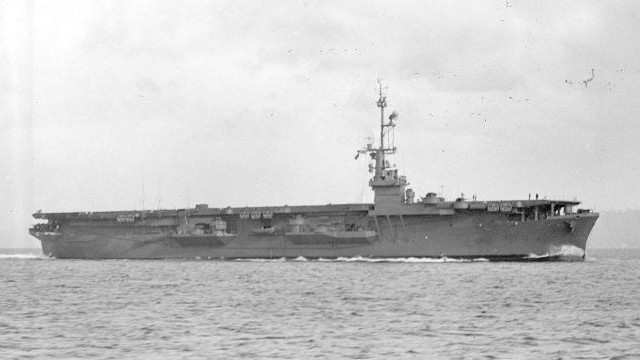
Get it right, and you will gain the people's ovation and fame forever. Get it wrong, and... uhm... nothing will happen. So there!
UPDATE: Since nobody's gotten it yet, I'll just give the answer. The ship pictured is CVE-123, the USS
Tinian. She was completed in just under six months, and was launched in September 1945. She was never actually comissioned, sailing right from acceptance trials into the Pacific Reserve Fleet where she sat until 1970. She was struck from the list on June 1st, 1970, and sold for scrap 18 months later. The
Tinian had never been a US Navy warship.
Posted by: Wonderduck at
05:32 PM
| Comments (10)
| Add Comment
Post contains 128 words, total size 1 kb.
1
I am going to do another wag, a CVE?
There were so many CVE's built that I cannot even start to guess a name.
Some of the ones transferred to Great Britain muddy the guessing even further.
Posted by: jon spencer at December 27, 2011 06:20 PM (hFoyt)
Posted by: Wonderduck at December 27, 2011 07:55 PM (f/6aJ)
Posted by: brickmuppet at December 27, 2011 08:53 PM (EJaOX)
4
I'm cheating (looking at Wikipedia), so if I'm right I don't win anything. It looks like it's a member of the Commencement Bay class.
Posted by: Steven Den Beste at December 27, 2011 11:18 PM (+rSRq)
5
There's nothing to win this time around, Steven, but it is indeed a member of the
Commencement Bay class.
Posted by: Wonderduck at December 28, 2011 12:29 AM (f/6aJ)
6
I would have suggested that it was
Commencement Bay itself, except that
Commencement Bay was given a "dazzle" paint job.
Posted by: Steven Den Beste at December 28, 2011 10:24 AM (+rSRq)
7
Odd. IIRC, if she was never comissioned, she should not have gotten an 'USS' prefix.
Posted by: cxt217 at December 28, 2011 04:07 PM (9V46Q)
8
I wondered about that as well. She was named at her launching, it appears, and I suppose the USS was simply applied at that time.
Posted by: Wonderduck at December 28, 2011 06:51 PM (f/6aJ)
9
So apparently what's distinctive about her is that she's the last CVE ever built.
Posted by: Steven Den Beste at December 28, 2011 09:36 PM (+rSRq)
10
Yes, and I meant to put that in the "Update" and completely whiffed on it. Being on vacation is relaxing, but it dulls the brain.
Posted by: Wonderduck at December 28, 2011 09:50 PM (f/6aJ)
Hide Comments
| Add Comment
December 24, 2011
God Mode / NoClip
Imagine, if you will, that you have the ability to travel back in time and space to one location during World War II. You will not be able to influence events, nor will your presence be noticed, but you will be able to see and understand anything you'd like in that location. Even if you don't know the language being spoken, you will know what's being said, what's being written, so on and so forth. You will, for all intents and purposes, be the ultimate historian. You
can travel, but only as far as conveyances of the day can take you: if you wanted to see the bombing of Coventry from the air you can, but it'd be from one plane only. If you want to observe the Marianas Turkey Shoot, it can only be from one p.o.v. (though you could start on an aircraft carrier and "board" a plane, even a fighter).
Perhaps unsurprisingly considering my personal interests, I'd choose the Battle of Midway. More specifically, I'd choose to station myself on the bridge of the USS
Hornet, just so I could find out what REALLY happened leading up to the "
Flight To Nowhere", and what occurred afterwards. I'd probably jump into Stanhope Ring's SBD to find out his reactions and to see his heading choice.
My second pick would to be onboard the
Akagi on June 4th, 1942. To see the events of Midway unfold from the standpoint of the Japanese would be nigh-on invaluable. My third choice would be May 27, 1941, onboard the HMS
Rodney, to witness the sinking of the
Bismarck, and to see if the
Rodney really
did torpedo the German battleship.
So what event would
you choose?
Posted by: Wonderduck at
01:48 PM
| Comments (5)
| Add Comment
Post contains 288 words, total size 2 kb.
1
I'd want to watch the planning for Operation Seelowe, to find out if it was a feint, or if Hitler really meant to go through with it. I've never found a straight answer to that, and it may be that no one knows.
Posted by: Steven Den Beste at December 24, 2011 03:15 PM (+rSRq)
2
I was to see why MacArthur's planes were caught on the ground, in the Philippines, even though he had plenty of warning after the attack on Pearl.
Posted by: Siergen at December 24, 2011 04:11 PM (GcG9m)
3
Steven took my first choice. I had also always wondered about that.
Second:
I would want to be on the Yamato during the action off Samar to find out why Kurita snatched defeat from the jaws of victory. No offense intended to Taffy3 who fought well and hard to the last, but the way was clear after the Johnston went down....yet....
Posted by: brickmuppet at December 25, 2011 12:59 AM (EJaOX)
4
Hitler's bunker when he shot himself. I mean, who wouldn't want to see that over and over again? :-)
Tokyo when the decision to attack the US was made, or the Japanese Embassy to find out if it really was accidental that the war declaration was simply late.
Maybe watch Audy Murphy in action to witness true heroism.
If we weren't confined to WWII, I'd want to find out what happened to Amelia Erhart.
Posted by: Mauser at December 25, 2011 06:08 AM (cZPoz)
5
Mauser, is
this what you were wondering about?

Posted by: Siergen at December 25, 2011 01:40 PM (GcG9m)
Hide Comments
| Add Comment
December 18, 2011
Hal Far Flight
One of the famous stories of World War II is that of the legendary defenders of Malta,
Faith,
Hope and
Charity. As the legend goes, when Malta was placed under aerial siege by the Italians in June of 1940, there were only three British fighters to defend the entire island. To make things even more grim, the fighters were obsolete Gloster Sea Gladiators, the last biplane fighter in RAF/FAA inventory. These three planes managed to hold back the Italian Regia Aeronautica until the Germans got involved in early 1941. It's a wonderful story, one that surely went a long way toward boosting British morale in those dark days of the War.
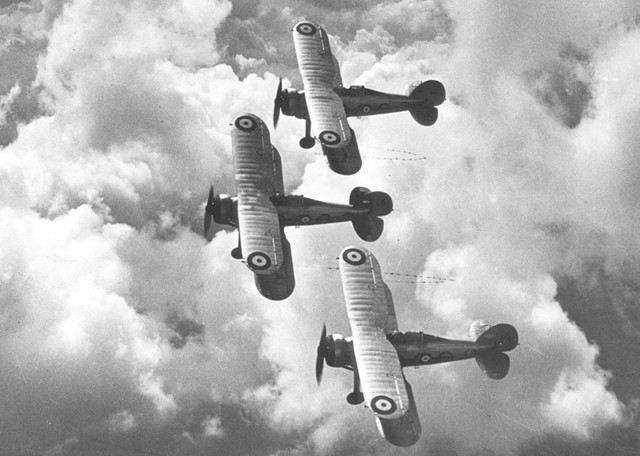
Like many of those types of stories, there's quite a bit of... um... let's call it
embellishment... involved.
more...
Posted by: Wonderduck at
08:03 PM
| Comments (4)
| Add Comment
Post contains 457 words, total size 4 kb.
1
With the proving of oil in Falklands waters it'll be interesting to see if 1435 Flight will fight again. I'm sure that Argentina didn't learn the 1st time, maybe a second time will do the trick.
Posted by: von Krag at December 18, 2011 10:39 PM (XIY2m)
2
JUST the fuselage? I hate seeing that kind of disrespect. It should be complete.
Posted by: Mauser at December 19, 2011 12:20 AM (cZPoz)
3
Mauser, it looks like there isn't room for the wings.
Posted by: Steven Den Beste at December 19, 2011 01:03 AM (+rSRq)
4
Also remember, we're talking about a 70+ year old plane whose wings were
fabric-covered. As near as I can figure, there's only seven Gladiators that have survived this long, and only two or three are still flyable. My guess is that the Malta War Museum just doesn't have the funds to even attempt to preserve the wings.
FWIW,
Faith is the only surviving Sea Gladiator. The others are all the regular type.
Posted by: Wonderduck at December 19, 2011 08:07 AM (f/6aJ)
Hide Comments
| Add Comment
December 07, 2011
70 Years
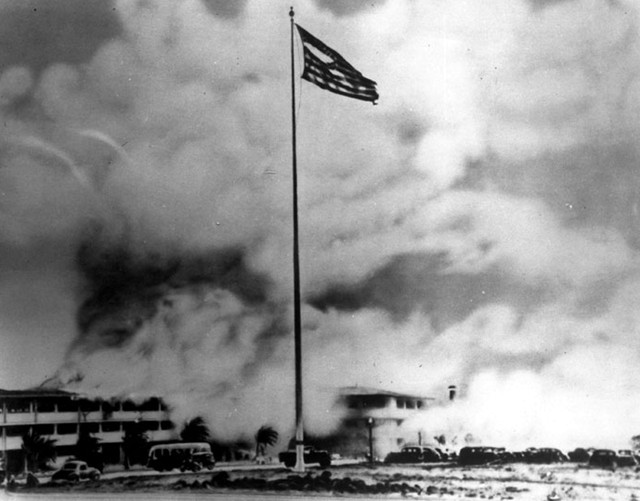
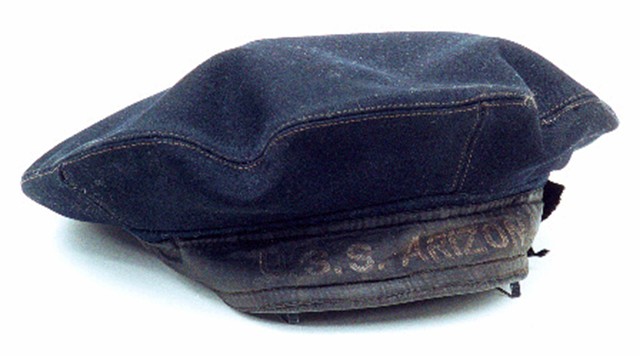
Today is the 70th anniversary of the attack on Pearl Harbor. It will also be the final one for the Pearl Harbor Survivor's Association, which will disband on December 31st, 2011, ending its 53-year existence. There may only be around 2000 or so men left of those who were at Pearl that Sunday morning. Today, we remember those who fought, those who died and those vanishing few who remain.
And we offer our thanks.
Posted by: Wonderduck at
12:05 AM
| No Comments
| Add Comment
Post contains 76 words, total size 1 kb.
December 06, 2011
Name This Mystery Ship IX
Just because I stumbled upon this story last week,
name this mystery ship!
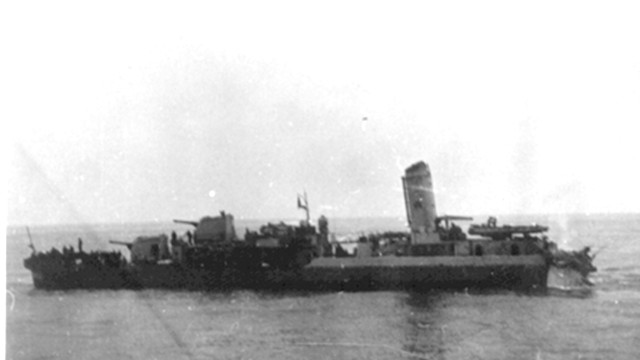
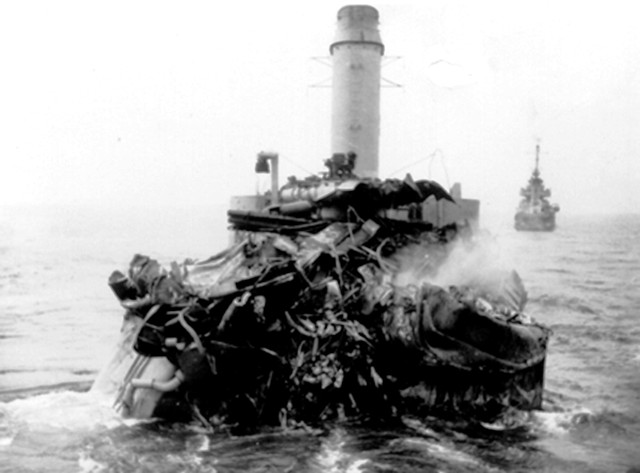
No cheating, folks... that takes all the fun out of it.
Posted by: Wonderduck at
04:48 PM
| Comments (8)
| Add Comment
Post contains 29 words, total size 1 kb.
1
Clearly that is DD-. I'm not sure what the designation of the missing front half is though....Ouch!
Posted by: David at December 06, 2011 04:52 PM (+yn5x)
2
Is this the one that turned in front of the Australian carrier?
I think that the DD that was hit had a helicopter hanger though.
Posted by: jon spencer at December 06, 2011 05:27 PM (hFoyt)
3
I'm guessing its the Murphy (Murphie?)...or at this stage in her career the Murp.
The bow of the Murphy is, IIRC somewhere off Delmarva and is a well known site because divers for years were looking unsuccessfully for the rest of the ship.
Posted by: brickmuppet at December 06, 2011 05:30 PM (EJaOX)
4
Brickmuppet for teh win! The USS
Murphy (DD-603) was on convoy escort duty, approximately 75 miles out from New Jersey when she encountered the SS
Bulkoil at night. The
Bulkoil was heading back to port after experiencing an engine failure when she heard a "torpedo" to port on her sound rig. Naturally, she turned into the "torpedo" so as to decrease her profile.
Problem is, the "torpedo" she heard was the
Murphy, tracking a sonar contact of her own out ahead of the convoy. The
Bulkoil hit the destroyer just behind the bridge and cut through, shortening her by about 70 feet. The bow portion sank in just a couple of minutes, taking 36 souls with it. The stern section stayed afloat, was towed back to New York Navy Yard, and seven months later emerged with a new forward section.
She served at D-Day then was eventually assigned to the Pacific Fleet where she was, apparently, one of the first (if not THE first) American vessel to reach Nagasaki after the bomb.
Posted by: Wonderduck at December 06, 2011 07:12 PM (2YMZG)
5
Yay!
I request Faith, Hope and Charity.
Posted by: brickmuppet at December 06, 2011 07:18 PM (EJaOX)
6
To clarify my request: Only as it applies to one of your illustrations in
this post.
Posted by: brickmuppet at December 06, 2011 07:24 PM (EJaOX)
7
David, you are thinking of HMAS Voyager that was cut in half by HMAS Melbourne. It also collided with USS Frank E Evans (obviously not at the same time).
Posted by: Carpe Jugulum at December 07, 2011 12:31 AM (ErkRV)
8
Actually, I wasn't thinking of any ship in particular. It was just obviously the rear "half" of a destroyer, and I felt like making some kind of comment.
I was also assuming that the damage was from a torpedo hit, not a collision, which explains why my search didn't lead me to an answer.
Posted by: David at December 07, 2011 10:36 AM (+yn5x)
Hide Comments
| Add Comment
December 01, 2011
Which Fighter Is Best? Part II: The Early Years
In December of 1941, when the United States joined the rest of the
world's industrialized nations in the first truly globe-spanning war,
there was a tremendous range of single-seat fighters both in use and
under design everywhere. However, to paraphrase a later persona, you go
to war with the military you have, not the one you wish you had. What
was a nation's front-line fighter plane in 1942 was obsolescent in 1943
and a death trap a year later. This entry will examine the best fighter
planes from the "early years," and decide which of them is the best.
Bear in mind, however, that in the hands of a talented pilot any one of
these planes could beat any of the others. None of them could be
considered a "dog," just perhaps not quite as good as the eventual
winner.
As previously mentioned, the US gets two planes, one from the Navy
and one from the USAAF, since the two services had completely different
design criteria which generated completely different fighters. The
Japanese, Germans and British get one entry each. 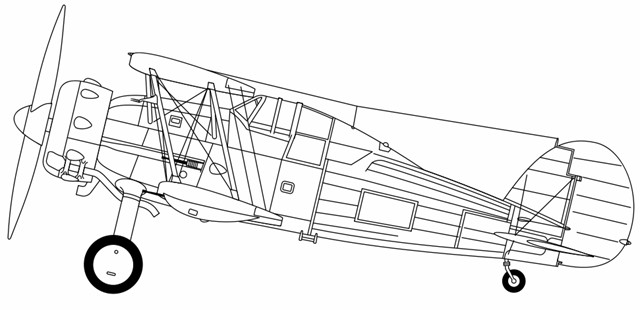
The entries are presented in no particular order. Let's get on with it.
more...
Posted by: Wonderduck at
11:21 PM
| Comments (19)
| Add Comment
Post contains 2298 words, total size 16 kb.
1
The biggest reason the P-40 did so well early in the war was because its pilots were very well trained and knew the plane. A squadron of P-40's fought out of Henderson Field for a while, and did very well against the Zero even though the Zero really was a much better plane.
I agree that the Zero was the best fighter of the early war.
Posted by: Steven Den Beste at December 01, 2011 11:39 PM (+rSRq)
2
SDB, I think the same argument can be made for the early success of the Zero as you made for the 40. But in any discussion of this type, my tendency is to look at the characteristics of the bird versus the ideal list of my wants. Then the preference for rugged and heavily-armed comes into play....
Posted by: The Old Man at December 02, 2011 06:10 AM (TcNy+)
3
It looks like you have a picture of an F4F-3. It clearly has "F-3" on the side, and I don't see any sign of the wing joints. That minor nit aside, great article, and great pictures. They all look like they were taken somewhat recently, I wonder how recent the BF109 and A6M pictures are, given that I don't believe flyable versions of either exist anymore.
I'd have to argue on throwing out the BF109 so early, just based on the results it achieved. I'd put it into the top three with the Spitfire and Zero.
Posted by: David at December 02, 2011 10:30 AM (+yn5x)
4
David, that would actually be the squadron markings, not the type number, though technically it's incomplete. The correct number would be X-Y-Z, where X is the Air Group Number, Y the plane type (Fighter, Bomber, Scout, Torpedo), and Z the plane number in the squadron. So in 1942, 6-F-12 would be the 12th plane of the fighter squadron of the USS Enterprise's air group.
Posted by: Wonderduck at December 02, 2011 11:20 AM (OS+Cr)
5
There were no P-40s serving at Henderson Field during the Battle for Guadalcanal. They had the P-400, which was a bastardized export version of the P-39. Almost completely unsuitable for air combat (All the more so because they had no ground equipment to keep their oxygen system charged.), but its heavy armament and payload made it invaluable for ground support. The pilots there learned the hard way to leave tackling the Japanese aircraft to the F4Fs.
The A6M was very maneuverable but at high speeds or high attitudes, that maneuverability almost completely disappeared to the point of the aircraft being uncontrollable. That was why Japanese pilots were reluctant to go into steep dives in the Zero.
Finally, it is easy to overemphasize the importance of maneuverability in a fighter. Pilot skill and tactics often were far more determinative of the fighter's performance - which aircraft had greater maneuverability was only critical for the few pilots pushing the edge of the performance envelope.
Posted by: cxt217 at December 02, 2011 04:29 PM (Zye/c)
6
The genius of the Thach Weave was that it pretty much eliminated the value of maneuverability, and instead emphasized weapons and armor, in which areas the F4F (and pretty much all later American fighters) vastly outrated the Zero.
Also, this is from Fire in the Sky:
In April 1943 No. 15 Squadron (RNZAF) arrived on Guadalcanal with P-40s. RNZAF fighter squadrons took part in many of the fierce engagements triggered by each new U.S. Landing farther up the Solomons. These engagements did much more than the Guadalcanal campaign to damage the JNAF, and by the time the JNAF abandoned Rabaul in April, New Zealand fighters had claimed ninety-nine kills
Posted by: Steven Den Beste at December 02, 2011 05:02 PM (+rSRq)
7
Regarding the suitability of P-39 for air combat, there's a funny picture here:
http://wio.ru/aces/rechkalov.htm
Every star on that cowling is a downed German aircraft (quite a few were 109s).
Posted by: Author at December 02, 2011 08:41 PM (G2mwb)
8
I had forgotten that the P-40 saw such wide use early in the war.
I do remember that the American Volunteer Group ('Flying Tigers') were taught to climb high and dive towards the Japanese planes they fought. At least, that was mentioned in the book I read, way back in high school.
Chennault (leader of the AVG) was big on using that advantage of the P-40.
About the Spitfire, Bf109, and A6M2: the mix of guns with different convergence zones is surprising. Did the pilots have the ability to select which set to fire? Or did they have to fire both at once, and hit with whichever one was aimed right?
Posted by: karrde at December 03, 2011 08:04 AM (+Zz5p)
9
The Spitfire did not; it either fired all guns or none at all. The other two could select to fire one type or the other (or both).
Posted by: Wonderduck at December 03, 2011 09:04 AM (2YMZG)
10
P-39 originally had the fire selectable, but in Russian service it was modified to all-or-nothing, as were domestic fighters (such as Yak). I am not sure exactly why it was done, perhaps it had to do with flying in heavy gloves.
Erich Hartmann said that he preferred minimum range shots.
Posted by: Author at December 03, 2011 02:35 PM (G2mwb)
11
Conventional wisdom is that the Spitfire had a better turning radius than the Me-109. In actual tests run between captured Spits and Me-109s, though, the Germans found that the 109 had a better turning radius at most altitudes and speeds. Because of the huge firepower advantage of the Emil, I would eliminate the Spit before the Emil.
As far as the Zeke, it had a really poor roll rate, especially before the reduction in wing size with the Model 32. It's a remarkable technological achievement, but I'd take the Emil every day of the week and twice on Sunday, so long as operational radius wasn't my primary consideration.
And the Emil is clearly better looking than that effete Spitfire.
8-)
Posted by: Doug Sundseth at December 03, 2011 02:36 PM (xdhJI)
12
The Brits disagree with you, Doug, as does every single reference book I have over here. The Japanese tested the A6M2 against the Bf109 (I can't find out which version), and according to them the only place the German fighter had any edge was in top speed.
I'll point out again that any of these planes could shoot down any other in the contest. We're talking tiny percentage points differences between the top three.
Some time ago, I mentioned that I had a "What If...?" post I had to let go because I didn't know enough of the history involved. The basis of that post was "What If... the Germans had replaced their 109s with Zeros at the Battle of Britain?" I suspected the difference would have been huge, but I couldn't (and still can't) track down all the various permutations that change would cause.
Posted by: Wonderduck at December 03, 2011 04:03 PM (2YMZG)
13
I want to say that the information came from a comment by Galland, but it was about 15 years ago when I read it (back when I was playing Mustangs and Messerschmitts seriously) and I have no idea how to find it now. IIRC, it's related to the behavior exemplified in this (from your link*):
"I had survived this mission simply
because the Spitfire could sustain a continuous rate of turn inside the
BF 109E
without stalling - the latter was known for flicking into a vicious
stall spin without prior warning if pulled too tightly.
The Spitfire would give a shudder to signal it was close to the edge,
so as soon as you felt the shake you eased off the stick pressure."
A good pilot could fly the 109 right on that edge, while an average pilot had to fly a few percent below that performance. With a Spit, even a relatively average pilot could hang on the performance edge. When combined with the 109s flying at the end of their endurance over England and the Spits flying over their own fields, the result was the performance differential that's usually reported.
"I'll point out again that any of these planes could shoot down any other
in the contest. We're talking tiny percentage points differences
between the top three."
Oh, clearly. To a large extent, the aircraft of the major combatants were direct responses to the challenges they faced during the war. The Japanese and Americans prioritized operational radius, the Japanese by sacrificing defense and the Americans by sacrificing maneuverability. American aircraft started significantly behind those of the Japanese and the Europeans, largely because of political concerns. The Germans and British sacrificed range for maneuverability or firepower.
The primary reason I'd choose a 109 over a Zero is that with good tactics, P-38s, P-40s, and F4Fs eventually attained something like loss parity with the Zero. And US experience in North Africa indicates that none of those aircraft could match the 109.
I'm treating this comment section in much the way I would treat the grognard discussion you alluded to in the first post in this series. And it wouldn't be that kind of discussion without disagreements opaque to anyone not in the in-group.
FWIW, when this is done, I'm willing to put forward the case that the Sherman is the most under-rated tank in WWII, (and arguably the best tank in WWII) as well**. 8-)
* An excellent data source, BTW, that I've not seen before.
** Seriously, not facetiously, but not based on which tank would win a tank duel.
Posted by: Doug Sundseth at December 03, 2011 10:14 PM (xdhJI)
14
Let's not derail. Fighters, folks,
not tanks!
Posted by: Steven Den Beste at December 03, 2011 11:24 PM (+rSRq)
15
Yes. the only tanks that could conceivably belong in this thread are the flying tanks from the 1930s and they were even worse dogfighters than they were tanks. So they wouldn't win anyway.
Posted by: brickmuppet at December 03, 2011 11:42 PM (EJaOX)
16
I thought brick was joking. I
was wrong. That's insane! I can very well appreciate why the Soviets ordered one of the designers to take a ride on one of those contraptions after a prototype disintegrated on landing...
I don't really know enough about fighters to have any strong opinions about them, except to follow the simple rule: the point of fighters isn't to dogfight, it's to assert and defend air supremacy over a theatre. That can be highly dependent on local conditions - logistics considerations, range, fuel efficiency, anti-aircraft artillery deployment, etc. What was the relative maintenance profiles of these aircraft, for instance?
Posted by: Mitch H. at December 04, 2011 08:20 AM (pvALX)
17
Even within the IJN in the discussions which led to the development of the Zero, there were experienced pilots who believed the emphasis on maneuverability to the detriment of other traits in a fighter design was a bad idea, and that inadequate maneuverability in a fighter could always be compensated for by improved pilot skill. Ultimately, those pilots were proven correct.
It is worth noting that most pilots did not push their aircraft to the limit. In that sense, arguments over the whether one fighter was more maneuverable tend to lead into a blind alley.
And as Len Deighton once noted, a common trait of all the highest-scoring aces like Hartmann was a willingness to get really close before opening fire on their targets. That fact led to one of the few peeves pilots had with the Spitfire - the mounts for the machine guns were simply too narrow to converge the fire of all the machine guns as close as the pilots wanted.
Posted by: cxt217 at December 04, 2011 06:05 PM (Zye/c)
18
With the correction that it's the turn rate that's important, not turn radius, Spit still won. Another important advantage that it had was that it shed energy slower than the competition (Mustang was the absolute champion though: it even had a maneuvering flap setting).
Posted by: Author at December 04, 2011 11:29 PM (G2mwb)
19
I just got emailed this, and it seemed relevant to this post... just about every plane mentioned appears at some point in the video, I think. Now excuse me, I'm going to go see if I can figure out how to get to England this summer..
http://player.vimeo.com/video/37599899
Posted by: David at March 13, 2012 03:41 PM (+yn5x)
Hide Comments
| Add Comment
November 28, 2011
Which Fighter Is Best? Part I: Introduction
If you stick two or more WWII otaku in a room, supply them with beer and pretzels and a suitable collection of Avalon Hill games, close the door and walk away, three things will happen:
1) the beer will disappear;
2) a game will be played (probably not
Source of the Nile, however);
3) an argument will break out.
Unless the argument is about the rules of the game being played ("Of course a T-34/85 can move in a lake hex... the rules don't say it
can't!"), it will invariably be one about "which is best". Best tank, best rifle, best navy, best game, best way to carry dice (Crown Royal bag), best infantry, the topics one can choose from are endless.
Except amongst the grognards I know, the discussion always veers to "best fighter." There would never be any structure to these arguments, devolving quickly to people championing their favorite plane, sometimes (depending on the amount of beer consumed) quite heatedly. Almost always the answer would end up being the P-51 Mustang, because, well,
look at it!
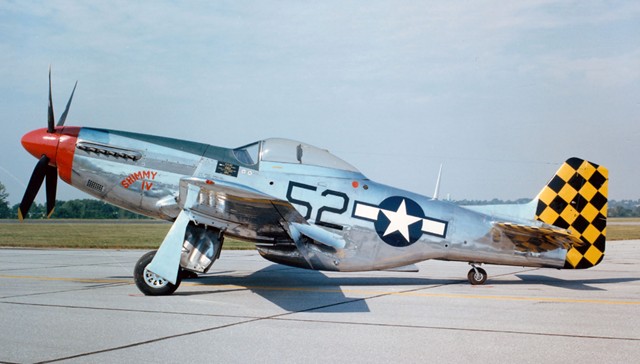
But is it really the best fighter of World War II?
more...
Posted by: Wonderduck at
09:48 PM
| Comments (36)
| Add Comment
Post contains 494 words, total size 3 kb.
1
"Early" American is the F4F and the P-38.
"Late" American is the F4U and the P-51.
But I wish there were a place for the P-47. It's underrated.
"Early" Japan is obviously the A6M "Zeke". "Late" Japan would be Ki-61 "Tony".
Posted by: Steven Den Beste at November 28, 2011 10:42 PM (+rSRq)
2
Oh, and you need a separate article about night fighters.
Posted by: Steven Den Beste at November 28, 2011 10:53 PM (+rSRq)
3
That's a... twin-engine... tractor/pusher configuration... fighter?
*blink* Well, crap, now I've gotta go research that thing.
(Oh, and this may be relevant to your interests:
http://twitpic.com/7lfwna)
Posted by: GreyDuck at November 28, 2011 11:03 PM (eHm8o)
4
That configuration wasn't unique. There were a couple like that.
Posted by: Steven Den Beste at November 28, 2011 11:12 PM (+rSRq)
5
GD, excellent solution!
Steven, what other plane used the Pfeil's layout? There were, obviously, a lot of pusher configuration planes, but very few t/p military aircraft that I'm aware of.
Posted by: Wonderduck at November 28, 2011 11:23 PM (2YMZG)
6
Another dividing line (which I admit is outside your parameters) is by the
mission performed by the aircraft. A plane which is a great short-range interceptor might not be good if employed on offensive fighter sweep, bomber escort, or ground attack missions...
Posted by: Siergen at November 28, 2011 11:32 PM (OSPjN)
7
Piaggio P.50, sort of.
During the P-38 design, Kelly Johnson considered a push-pull configuration.
The Fokker D XXIII
had a push-pull configuration, but only one prototype was built.
The Russian "Moskalev SAM-13"
was another.
Now the configurations of those others are not exactly the same as the Do
335, but it shows that the idea of a pusher-puller configuration was in the air,
though no one ever really made it work well.
Posted by: Steven Den Beste at November 28, 2011 11:42 PM (+rSRq)
8
Spitfire or Hurricane? (grin, duck, flee for life)
Posted by: Avatar_exADV at November 28, 2011 11:53 PM (pWQz4)
9
That's not controversial. The Spitfire was unquestionably better than the Hurricane, even early in the war. Later versions of the Spitfire were even better.
The main reason the Hurricane was important during the Battle of Britain is that the UK had twice as many Hurricanes as Spitfires. So the Spitfires tried to keep the 109's busy, so that the Hurricanes could attack the German bombers.
Posted by: Steven Den Beste at November 28, 2011 11:55 PM (+rSRq)
10
Any room for the Messerschmitt Bf-109 E or even the K?
How about the Focke-Wulf 190 D?
Posted by: Geirr at November 29, 2011 12:41 AM (vC/2p)
11
Not a fighter, but I've always been in love with the B-25 Mitchell. I mean, with up to 18 forward-facing .50's (If you aim the turrets forward) it's the 1940's equivalent of a disintegrator beam.
And who else could field a 75mm Howitzer until the AC130 gunship?
Posted by: Mauser at November 29, 2011 03:53 AM (cZPoz)
12
Mine are very close to SDB's.
Can I add the P-40, as used in China by the American Volunteer Group?
It's an American plane flown by Americans in the Chinese theater of the war against Japanese. And it had the most amazing paint-job ever seen on a WWII aircraft.
But I don't know where it would fit. And I'm not sure it compares, in performance terms, to the other planes in the war.
Posted by: karrde at November 29, 2011 07:35 AM (YjM//)
13
@#8+#9: Avatar, Steven, remember the rules... "planes won't appear in both Early and Late contests." I even specifically mention the Spitfire; we might be seeing the Hurricane anyway!
@#7 Steven: So, no planes with a pusher/tractor config that flew more than prototypes.
@#11: Maybe I'll do a "medium bomber" thing. Not likely, but maybe.
Posted by: Wonderduck at November 29, 2011 07:47 AM (2YMZG)
14
Early period, FW-190 and the Spitfire.
Late period, P-51 and the Corsair.
Imo, the P-51 is the best fighter of WWII period. It's range plus combat performance was unmatched.
I refuse to list any Japanese fighter as 'best' because they sacrifice pilot safety for performance. They were deathtraps.
Posted by: TBlakely at November 29, 2011 08:47 AM (GAYHS)
15
FW-190 took a long time to reach the front service. It's a late-war plane for all practical purposes.
A. Yakovlev wrote in his memoir that during the infamous visit of 1940, Kurt Tank got drunk and bragged how he developed an airplane that could reach 700 km/h. When asked about it next morning, he said that the arplane has just suffered an accident and cannot be demonstrated. Hur hur hur.
Posted by: Author at November 29, 2011 12:20 PM (G2mwb)
16
I, too, think that P-47 was underrated. However, being underrated it still wasn't the best. The biggest downside, IMHO, was how one had to be Robert S. Johnson to get results with it. P-39 was well-liked in Russia and produced a few aces. And Yak-3 of course was an amazing sports car of a fighter, too. Neither of those was as good as P-51.
Posted by: Author at November 29, 2011 12:24 PM (G2mwb)
17
Gotta take the Jug and P-38, followed by the Bearcat and the Corsair. I'm a big believer in ruggedness married to firepower. 11/11 I talked to a guy who had flown both the Jug and the Pony. Claimed the Jug was the toughest bird in the air and the 51 was a sweetheart to fly...
Besides, those 12 hour missions in a 51 would bloody MURDER my 'roids...
You know how to open those cans-o'-worms, doncha Duck?
Posted by: The Old Man at November 29, 2011 12:53 PM (TcNy+)
18
I do, as a matter of fact. Alas, the F8F Bearcat never made it into WWII, so it can't be considered. Ditto the F7F Tigercat.
Posted by: Wonderduck at November 29, 2011 01:29 PM (OS+Cr)
19
Early British is always the Spitfire - though as others have pointed out, the Spitfire may have been less cost effective than the Hurricane (For example, from production and servicing standpoints, you could build ~566 Hurricanes for 20,000 man-hours versus ~290 Spitfires for 24,000 man-hours.). Late war British was the Tempest (Although the fighter/fighter-bomber versions of the Mosquito almost won out.).
Posted by: cxt217 at November 29, 2011 03:35 PM (VVfk8)
20
Not a fighter, but I've always been in love with the B-25 Mitchell. I
mean, with up to 18 forward-facing .50's (If you aim the turrets
forward) it's the 1940's equivalent of a disintegrator beam.
The strafer version of the B-25 wasn't the original configuration. It was actually a hack developed in Australia. They'd been given B-25's, but they were useless for the kind of war being fought in New Guinea. So the general in charge of air resources there let one of his guys, one Pappy Gunn, and he decided to completely change the mission.
He's the one who got rid of the bombardier, loaded a pile of machine guns in the nose, and so on. The result was so successful that North American sent a group of engineers to Australia (no easy trip at the time) to see what he'd done.
Then they came back to the US and deliberately designed a strafer version of the B-25 to manufacture.
It's one of the cooler stories of the war. But the B-25 strafer isn't a fighter, so it isn't relevant to this thread. (Alas.)
Posted by: Steven Den Beste at November 29, 2011 03:54 PM (+rSRq)
21
I recall reading Saburo Sakai's autobiography where at the close of the war he was assigned to a squadron with one of the late-war Japanese fighters that wasn't a deathtrap (resealable tanks, etc.) and that he took down a B-29 with it. I'd say Shinden, but that doesn't seem right somehow.
Mauser: For ground attack, though I love the Ilyushin Il-2 Shturmovik, nothing beats the Hs129 B3 as far as sheer audacity and coolness of potential - a purpose built single-seat twin-prop ground attack aircraft mounting a 75mm AT gun. (http://en.wikipedia.org/wiki/Henschel_Hs_129)
Posted by: Civilis at November 29, 2011 05:24 PM (oFqV0)
22
Mauser, many years ago I saw a Canadian Warbird Heritage B-25 at the Oshkosh fly-in that was piloted by someone who know how to make the most of it. He was flinging that thing around close to the ground like it was a fighter; I was very impressed. I just wish I'd had a movie camera handy - I doubt I'll ever see one flown like that again...
Posted by: Siergen at November 29, 2011 05:39 PM (OSPjN)
23
Early War:
USN - F4F, since there's really no other choice. That is to say, "None".
USAAF - P-47
RAF - Spitfire
Luftwaffe - FW-190A (Easily the best early war fighter, given that "early war" goes into 1943. If the 190 is chosen for late war, then Me-109E, since the Emil was arguably the best WWII fighter until the FW-190 entered service.)
Japan - Zero-sen
Late War:
USN - F4U
USAAF - P-51D
RAF - P-51 (First used in British service and the Merlin makes it British -- yes, it's a stretch. 8-) )
Luftwaffe - FW-190D
Japan - None
USSR - None
So, for the argue-off, do we consider the best available variant, regardless of date of entry (for those aircraft that spanned both periods) or only the best available by the end of the period. If the former, then aircraft with wide capability variance might arguably be better entered as separate aircraft in each period. (FW-190A and D and Spitfire Mk. whatever come to mind.)
Posted by: Doug Sundseth at November 29, 2011 07:01 PM (xdhJI)
24
Russians never thought much about the combat effectiveness of He.129. It was considered a paper tiger. It arrived late in the war, when Russian air cover was much better, fighters were heavily armed and flown better. The 129 did not do much against Russian tanks.
As far as B-25 with 75mm, Jack Ogilvie wrote this:
"Yes I remember those flights very well, I think I was on all of them.
They were not bomb runs,those were B-25's that were fitted with 75 mm
cannons and they were trying to knock out some flak boats that were in
the harbor at Leghorn. They had a gun emplacement on a point going in to
the harbor that had two 105's and several 88's. They were the most crack
shot's I ever saw. They had a gung ho full colonel that was in charge of
the Squadron and he had us come to the briefing. His plan was to go in
with three flights of four planes and to go in four at a time stacked
one behind the other on the deck,we were to be circling above them. I
tried to talk them out of it and he got mad as hell. When we started in
and were maybe a mile out those 105s shot four rounds and knocked down
four planes-the rest scattered and aborted the mission. The colonel had
another meeting and ranted and raved and threatened court-martials for
cowardice. He said he was going to do the same thing the next day and
would lead the flight. He did and the first round was a direct hit on
his plane. As far as I know they were never used again."
The story of cannon-armed B-25 stuck with me because it was such a disappointment. Americans were supposed to fight smart, not like this. Of course I did not know about the "Flight to Nowhere" back then.
Posted by: Author at November 29, 2011 07:48 PM (G2mwb)
25
There are idiots in every branch of every military in the world.
Keep the comments coming, folks! You've already forced me to reconsider one of the planes for the "Early" fighters... which is forcing me to postpone the entry until tomorrow.
Posted by: Wonderduck at November 29, 2011 07:53 PM (2YMZG)
26
Civilis, the Shinden never saw combat. The first test flight was three days before Hiroshima. There were only three test flights altogether, totaling about 45 minutes of air time.
It was probably the Ki-61, which did have self-sealing fuel tanks.
Posted by: Steven Den Beste at November 30, 2011 12:41 AM (+rSRq)
27
SDB: IIRC, the Australian modified B-25's had the extra gun mounts in the wings, which was never an official configuration, and the engineers didn't think the structure could support it properly, so they came up with the nose mount, in both 4 and 8 gun flavors. Plus there were nacelles around the fuselage for guns, which required steel reinforcement plates on the skin to protect from the muzzle blast.
They were also successful at "Skip Bombing", which is a trip to see film of.
There's a lot of stuff on YouTube.
Posted by: Mauser at November 30, 2011 06:38 AM (cZPoz)
28
Well, the book "Fire in the Sky" says that the original Australian B-25 strafers mounted the extra machine guns on the outside of the nose of the plane.
Posted by: Steven Den Beste at November 30, 2011 10:13 AM (+rSRq)
29
US: Late B-25, the triple threat: "We bombs em, we strafes em, and we falls on em."
USSR: Early P-39
Posted by: DonM at November 30, 2011 12:13 PM (L6j+c)
30
Fighters, guys. Fighters.
Posted by: Wonderduck at November 30, 2011 12:59 PM (OS+Cr)
31
Fighters, guys. Fighters.
Them's fight'n words...
Posted by: Siergen at November 30, 2011 07:34 PM (TR6md)
32
I suppose the P-47 doesn't really rate "best". But what other fighter plane has an enemy destroyer to its credit?
Those two guys from the Tuskegee Airmen were flying P-47's when they sank a destroyer in the Adriatic. (The TV movie had them flying P-51's, but that squadron didn't get P-51's until later.)
This was after Italy surrendered, and the destroyer in question was originally Italian but was reflagged and recrewed by Germany.
I've watched that gun-camera film several times, and I've come to the conclusion that one of the machine gun rounds set off the warhead on a torpedo. Of course, that would then set off all the others in the rack, and the resulting explosion was more than sufficient to blow the ship in half.
I don't know of any other case like that in the war.
Posted by: Steven Den Beste at November 30, 2011 11:35 PM (+rSRq)
33
Come to think of it, late war fighters which were carrying rockets or bombs might well have bagged destroyers. But that P-47 was using its machine guns.
Posted by: Steven Den Beste at November 30, 2011 11:36 PM (+rSRq)
34
Hmmm, the P-38 Lightning qualifies for BOTH periods.
Posted by: Mauser at December 01, 2011 03:25 AM (cZPoz)
35
US Late war (1944-on):
The Seahawk without floats!

Posted by: brickmuppet at December 03, 2011 03:21 PM (EJaOX)
36
Hey! I just found another push-pull airplane. Even better, it's got a canard!
Rutan Model 40
Posted by: Steven Den Beste at January 25, 2012 05:59 PM (+rSRq)
Hide Comments
| Add Comment
November 07, 2011
Attention To Orders
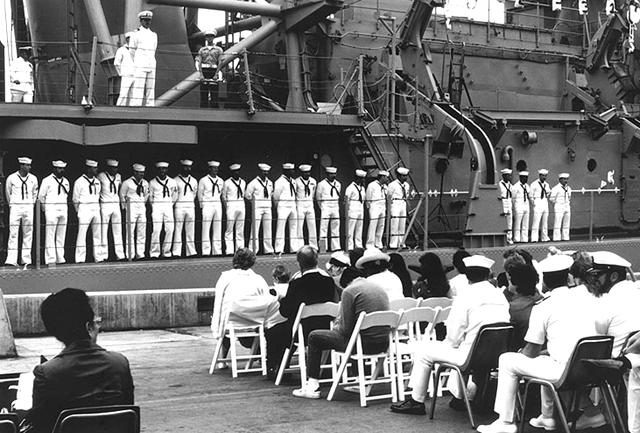
I would like to call your attention to the creation of a new category here at Wonderduck's Pond. It's been a long time coming, and it's an even longer time overdue, but I'm happy to finally announce the debut of the "
Military History" category. It'll take some time to get everything sorted out and filed away, but now there's someplace to put my military stuff other than the "various" bucket.
I'm actually surprised at how much MilHist stuff I've written... should have done this a long time ago.
Posted by: Wonderduck at
08:58 PM
| Comments (4)
| Add Comment
Post contains 91 words, total size 1 kb.
1
I didn't even realize you
had categories...
Posted by: Siergen at November 07, 2011 10:02 PM (sOpcO)
Posted by: Wonderduck at November 07, 2011 10:24 PM (o45Mg)
3
No, see, that was a compliment.
Categories are filters.
If someone is unaware that you have categories, then either they read everything you write, or they read nothing that you write.
Siergen replied to this article.
Thus, he reads everything you write.
Posted by: Mikeski at November 08, 2011 03:49 PM (GbSQF)
4
Yeah, what Mikeski said.
Also, if you can get the right balance between lack of sleep and cold medicine dosage, your blog articles flow together into one continuous stream of consciousness. Seriously, the F1 racers were beating the crap out of the rubber ducks at Midway, but then Rio starting altering probability again...
Posted by: Siergen at November 08, 2011 09:18 PM (sOpcO)
Hide Comments
| Add Comment
November 03, 2011
Name This Mystery Ship VIII
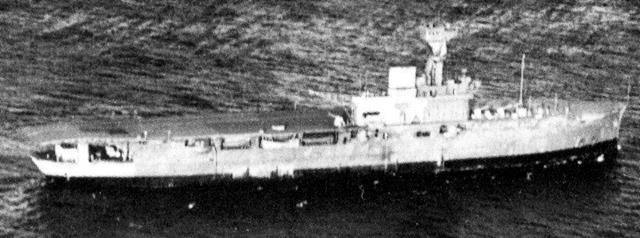
Go ahead, name this mystery ship! I dare you! If anybody gets it, they get a post of their own choosing (and I'll dine upon my chapeau).
Posted by: Wonderduck at
10:55 PM
| Comments (13)
| Add Comment
Post contains 32 words, total size 1 kb.
Posted by: brickmuppet at November 03, 2011 10:56 PM (EJaOX)
2
WRONG!!! *points, laughs*
Posted by: Wonderduck at November 03, 2011 10:59 PM (o45Mg)
3
I was going to guess the USS Sable or USS Wolverine, the training carriers that sailed mostly in Lake Michigan.
But the pictures don't quite match up.
It was a wag anyway.
Posted by: jon spencer at November 04, 2011 04:48 AM (hFoyt)
Posted by: Wonderduck at November 04, 2011 07:48 AM (o45Mg)
5
There's a point of honor about not using Google image search, right?
Posted by: Ed Flinn at November 04, 2011 08:46 AM (RRq7w)
6
Ed, I have no way of knowing if you're doing so. I think it's cheating and that you're less of a human being if you do, but I can't stop someone from using it.
I can understand the temptation; after all, a post on a topic of your choice is an incredibly valuable thing *rolls eyes*. I don't condone it, but I understand it.
Posted by: Wonderduck at November 04, 2011 11:21 AM (o45Mg)
7
Only carrier I can come up off the top of my head with an island configuration like that is HMS Eagle. But some of the hull details do not match up.
Posted by: cxt217 at November 04, 2011 02:15 PM (Igsff)
8
On a couple of previous "name that ship" competitions, after I'd given up, I did an image search just to see, without any intention of using that as my answer. Neither time did I get a result.
Posted by: David at November 04, 2011 02:56 PM (+yn5x)
9
Oh....I just realized my mistake. You got a GOOD one, Wonderduck! Hats off to you!
I take back my guess - it is not HMS Eagle, and you ruled out HMS Hermes. That means it is S.S. Mamari or Fleet Tender C. A decoy ship used by the Royal Navy during Big Mistake #2 to fool the Luftwaffe.
Good one!
C.T.
Posted by: cxt217 at November 04, 2011 03:12 PM (Igsff)
10
CXT got it! Name your prize, C... remember, no pr0n, politics or religion, but otherwise anything goes.
Posted by: Wonderduck at November 04, 2011 05:31 PM (OS+Cr)
11
Also, what style/flavor of hat are you going to feast upon?
Posted by: Siergen at November 04, 2011 05:52 PM (sOpcO)
12
Dang. I know I didn't win, but how about a post about the "fleet tenders"?
Posted by: V. Duck at November 07, 2011 10:44 AM (XVJDy)
13
Sorry about the delay in getting back but I have been preoccupied with a few things over the weekend. Some pleasant, some not so much.
Hmmm....Let me think about that, Wonderduck. I have to go really deep to find something that I like covered (At least with regards to military history.) for a write-up. Hmmmm....
Posted by: cxt217 at November 08, 2011 03:27 PM (50e3V)
Hide Comments
| Add Comment
October 29, 2011
The Flight To The Battle of Midway Roundtable
Back on October 6th, I posted a 3000-word article on
The Flight To Nowhere, the disastrous mission of the USS
Hornet's Air Group on the first day of the Battle of Midway. After I posted it, I realized that it was actually pretty decent. On a whim, I sent a link to the post to Ronald Russell, author of the book
No Right To Win and the webmaster of the
Battle of Midway Roundtable.
The BOMRT is an online gathering of historians, authors, interested amateurs, and (most importantly)
veterans of the Battle of Midway. It's probably the foremost online resource on the events of Midway, which explains why pretty much anybody who's written a book on the Battle or related topics in recent years is a member; Jon Parshall and Anthony Tully, John Lundstrom, Robert Cressman, Alvin Kernan, Robert Mrazek, Norman Polmar, amongst others.
A few hours after I sent the link to Mr Russell, I got a response with a few notes and a willingness to use the post in the next "issue" of the BOMRT Newsletter. To say this is something of an honor is understating the matter a bit; short of the article actually being published somewhere, that's about as good as it gets for an "interested amateur" like myself.
The new issue of the Newsletter was posted today. You can find the relevant
"Now Hear This" page right here.
I'm somewhat chuffed.
Posted by: Wonderduck at
10:30 PM
| Comments (5)
| Add Comment
Post contains 244 words, total size 2 kb.
1
Congrats! How does it feel to be a historian?
Posted by: Avatar_exADV at October 29, 2011 10:55 PM (GJQTS)
2
First, my congratulations.
Now, on to substance: there's been something about your post that's bothered me ever since. Your fundamental supposition is that when a military commander's mistakes can lead to the deaths of his subordinates, then he should be held responsible for them and relieved of command.
I understand the feeling that losing people should be a high burden and a huge black mark. But, well, everyone makes mistakes, and that's true during war just as much as in any other time. If we insist that our generals and admirals be perfect, we won't be able to come up with any admirals or generals.
There isn't a single major allied commander in WWII who didn't have at least one such blunder to his name. For instance, there was Halsey and Typhoon Cobra. Nimitz screwed up in not taking the reports of torpedo failures seriously enough early enough, defanging his submarine force for most of the first year of the war.
Spruance is often accused of not being sufficiently aggressive. MacArthur... well, the list of his mistakes is a long one.
And that was true in Europe, too.
It's been said that everyone makes mistakes in war, and the side that makes the fewest wins. But no one ever manages to get through with no mistakes at all.
If Nimitz had been as eager to can people for mistakes as you implied he should have been, then who would he have had as commanders by the end of the war?
Nimitz knew that mistakes were inevitable. But he also could tell that men like Marc Mitscher were valuable, and he couldn't spare them even if they screwed up royally.
Posted by: Steven Den Beste at October 30, 2011 12:39 AM (+rSRq)
3
Where is, repeat, where is Task Force 34? The world wonders...
I don't know if that extends to whitewashing the record, though. It's one thing for high command to get accurate reports of a screw-up and then to decide that it doesn't merit disciplinary action. It's quite another if they just don't know what really happened because someone's CO covered their ass.
The Japanese had a bad case of that, especially when it came to cross-service information sharing. The Japanese army knew it was over-committed; the Japanese navy knew (after Midway, anyway) that it couldn't win in a standard fleet action. But each service thought the other was in much better condition than it was. Lots of "if only they had been honest with us!" in after-war comments. Of course, they lost the war...
Posted by: Avatar_exADV at October 30, 2011 02:55 AM (GJQTS)
4
Steven, Av's got the right of it... I AM more concerned about the "sweeping it under the rug" aspect and the blatant falsification of records than I am the "he made a mistake" aspect.
People make mistakes. But it's fairly clear that Ring should never have been in the position of command that he had, it cost two squadrons of aircraft and many people their lives for no material gain against the enemy, and
then for all intents and purposes he got rewarded and promoted for his failure. That's what I have the biggest problem with.
Posted by: Wonderduck at October 30, 2011 08:59 AM (o45Mg)
Posted by: Siergen at October 30, 2011 06:17 PM (CfQd5)
Hide Comments
| Add Comment
October 06, 2011
The Flight To Nowhere
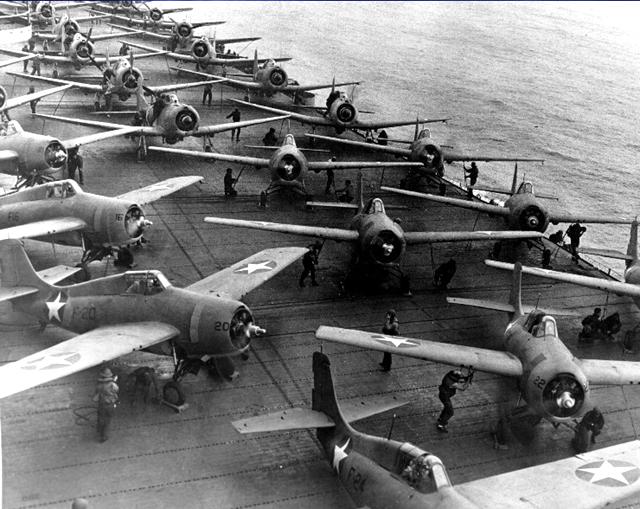
At 7am on June 4th, 1942, the signal was flashed to the American aircraft carrier USS
Hornet: "Begin launching aircraft." The plan to ambush the Japanese
Kido Butai had worked perfectly so far. The
Akagi,
Kaga,
Hiryu and
Soryu were some 155 miles away, long range for the 59 planes of the
Hornet's Air Group launched that day, but quite doable.
By noon, only 31 planes had landed at Midway or on the
Hornet. All were SBD Dauntless dive bombers. None of the TBD Devastators of Torpedo 8 or the F4F Wildcats of Fighting 8 had landed aboard, and never would. None of the SBDs of Scouting 8 or Bombing 8 had even seen the Japanese carriers. One third of the striking power that the US Navy had so carefully positioned had been completely wasted.
What had happened during those five hours became one of the US Navy's deepest (but open) secrets, suspected but unproven for over 45 years. It cost the lives of 31 airmen. It should have torpedoed the careers of two men destined to become admirals. It was The Flight To Nowhere.
more...
Posted by: Wonderduck at
11:00 PM
| Comments (19)
| Add Comment
Post contains 3052 words, total size 23 kb.
1
Nice post! I didn't know about this.
Posted by: Steven Den Beste at October 07, 2011 05:35 AM (+rSRq)
2
Out-bloody-standing, my friend. Now Ring is right down with "Swede" Larsen in the pantheon of screw-ups.
Nicely done and a smooth read. Gotta love it.
Posted by: The Old Man at October 07, 2011 10:05 AM (TcNy+)
3
I never thought of Swede Larsen as being a screw-up, oddly enough. A martinet with delusions of godhood who couldn't command his way out of a wet paper bag yes, but not a screw-up.
Posted by: Wonderduck at October 07, 2011 11:12 AM (OS+Cr)
4
I'd heard of references to this screw up once or twice, but I'd never seen a full detailed description like this. I'm sure they're out there, but here you have a clean readable blog post with a good explanation of the facts and consequences. Bravo!
Posted by: David at October 07, 2011 11:48 AM (ttXyi)
5
It should be noted that Mitscher exerted a baneful influence on the planning of Hornet's air operations even before the battle was joined. He had a major say in the poor coordination between the escort fighters and the bombers which would have led to major disaster had the Hornet's birds attacked the Japanese carriers. And unlike Enterprise's George Murray, Mitscher did not redeem himself at all with his later actions through-out Midway for his earlier mistakes.
Even before Midway, the less than adequate performance of Air Group 8 had caused Bull Halsey to stand them down one day to conduct more training.
The performance of Hornet and Mitscher at Midway had ramfication for the latter during the war. Raymond Spruance's style of command depended on giving wide latitude to trusted subordinates, which meant less well regarded officers like Mitscher (When Spruance was CO of 5th Fleet, and Mitscher ran the Fast Carrier Force.) were kept on a tight reign. In Mitscher's case, that was probably a good move, since the man did not confine his mistakes to the decisions he made on Hornet. That includes the mishandling of his crucial decision to turn on the lights at Philippine Sea.
Then we have William Halsey's performance as fleet and theater commander, but that is another story.
Posted by: cxt217 at October 07, 2011 12:04 PM (ZGQLT)
Posted by: Siergen at October 07, 2011 05:09 PM (oK555)
7
Holy cow. I swear I've read and seen a lot of Midway stuff, and bitter stuff was mentioned about the coverup, but nobody ever explained what happened and who covered it up. Educational for sure.
Also, Bath and Body Works has pink sparkly light-up bath duckies. Goodness knows why, but they do. I will think of them as Twilight vampire ducks, in keeping with the Halloween items elsewhere in the store.
Posted by: Maureen at October 07, 2011 08:38 PM (VF957)
8
IIRC, Mitscher had already been tapped for a promotion to flag rank as well as a position in Washington by time Hornet sailed for Midway. Since the US won the battle, the Powers That Be probably decided that there was little gain from sacking people (However deserving some were.). And yes, his replacement as captain of the Hornet was aboard the carrier at Midway, but graciously delayed the change of command so not to create confusion and uncertainty on the eve of battle.
Posted by: cxt217 at October 07, 2011 09:29 PM (ZGQLT)
9
CXT, that's why I said he was Captain (Admiral select). His next duty was as commander, Patrol Wing 2, not a Washington tour. That didn't come until 1946.
Posted by: Wonderduck at October 07, 2011 11:13 PM (o45Mg)
10
My bad. I realized that I somehow missed that piece. And I had always thought that Mitscher had been scheduled for a post in the BuAer after
Hornet.
Posted by: cxt217 at October 07, 2011 11:19 PM (ZGQLT)
11
Excellent job in tying all the threads together on something as complex as the Midway battle. I, too, had read Walter Lord's book as well as several other accounts, but had never read as nice a summary of Hornet's AG fubar as yours. Bravo zulu, WD.
Posted by: jt at October 08, 2011 11:12 AM (NmSN+)
12
Excellent post, fun to read. Really clarifies the mess. Parshall and Tully make the point in Shattered Sword that there was a real contribution to the battle by the VT-8 - it changed the course of the Kido Butai, which delayed search efforts for the American fleet. Also, smoke laid by the cruisers and anti-aircraft fire may have helped Lindsey's squadron locate the Japanese ships a half-hour later. Waldron's a real hero.
Posted by: Vaucanson's Duck at October 08, 2011 03:40 PM (OFJiW)
13
I enjoyed your article a lot, however, there are a few amplifying comments that are food for thought, if nothing else. LCDR Waldron had the opportunity and did object to the course of attack selected by CMDR Ring at a meeting attended by the other three squadron commanders and CAPT Mitscher just prior to the launch of Air Group 8. During that meeting, Waldron did strongly object to Ring's plan in favor of his own, but Mitscher himself ordered Waldron to follow Ring's plan. I believe that it was Mitscher's and Ring's plan that the Hornet's planes were deliberately intended to fly practically due west to intercept the course of approach of the Kido Butai to Midway, well north of their reported location, and then to turn left as a group and parallel the course of the Kido Butai until they intersepted the Japanese carriers which would then be retiring from Midway. Had this plan been followed by the entire air group, I think there is little doubt that the Japanese would have been sighted and attached by the entire air group.
Now, as far as the official report of the Hornet is concerned, it would have been very difficult if not impossible for Mitscher to have written that Waldron had not only disobeyed orders to maintain strict radio silence but also disregarded Mitscher's and Ring's specific orders to follow Ring's Plan of Attack, and not court martialed the dead hero, Waldron. It would likewise have been difficult for Mitcher not to have court martialed at least two of the other three squadron commanders for also disregarding Ring's orders to continue with the original plan of attack.
Posted by: Jim Scanlon at October 30, 2011 10:57 AM (HoE4S)
14
Jim, that's quite correct. Regarding your comments on the official report, however, I have two points. First, I'm not at all sure you can court martial a dead man. I can't find any record of it ever occurring in the US. Second, while Mitscher may very well have had to charge Rodee, Johnson and Mitchell, at what point does simple self-preservation trump orders? I find it hard to believe that the squadron leaders would be found guilty of disobeying orders when those orders were guaranteed to run their squadrons out of fuel.
Regarding your first point, VB-8 essentially followed that same flight profile. They never sighted
Kido Butai, and never really came near it. Their nearest approach would have come around 1020 on the Weisheit map, approximately fifty miles. VF-8 would be down to about 20 minutes of fuel, the Dauntless crews would have to assume they would be swimming home. VT-8, carrying the torpedoes would, like as not, already be in the water. If that really was Mitscher and Ring's flight plan, it probably would have cost the
Hornet her
entire Air Group for even less effect than what it actually managed, instead of half of it.
Posted by: Wonderduck at October 30, 2011 01:19 PM (o45Mg)
15
Thank you. I have been looking for a clear article on this and you have done a great job. I was hoping to do something on this for my website, but now I don't need to!.
My take is we needed heroes. we got them, but not necessarily the right ones.
Best,
Jay Hambleton
Posted by: Jay Hambleton at December 10, 2011 11:20 AM (cbxDt)
16
George J Walsh, next time just include a link instead of copying 1000 words from somewhere else. Like this:
Essay Here.
Posted by: Wonderduck at December 22, 2011 09:43 PM (f/6aJ)
17
People, did you try to analyse or simply COUNT the data from that nice chart above?
For example, the distance between the point were VF-8 claimed turned about 0910 and point were they ditched at 1040 (1.5 hours) is not less than 266 nautical miles even along the straight line! It means not less than 177 knots speed during fighters' return leg! Almost 50 knots more than F4F-4 cruising speed! It was only one example, but the timings, distances and speeds of other "tracks" are even more fantastic than VF-8's ones.
So you can believe in that revisionist Ñonspiracy rubbish as much as you want, but I recommend you to read discussions on
The Battle of Midway Roundtable website, were the Midway veterans of VS-8 and VB-8 disproved Weisheit's fantasies.
Posted by: Midnike at February 19, 2012 01:46 PM (af8bp)
Posted by: Steven Den Beste at February 19, 2012 02:07 PM (+rSRq)
19
The Battle of Midway Roundtable? I've heard of it... assuming you're talking about
the same BOMRT that featured this very post in its "Now Hear This!" page in October 2011? I appreciate that some of the veterans of the squadrons disagree with Weisheit; heck, in some instances I do, too. But you're missing the point.
Arguing that the F4Fs of VF-8 didn't make it back to the
Hornet, or weren't found to the northeast of Midway, or that the SBDs didn't leave Ring, or that
Hornet's Air Group wasn't completely frittered away on a useless flight to nowhere, is ridiculous. I grant that it's quite possible that the tracks on the map aren't exact... and that there's no way to prove the matter either way. Given.
But Ring screwed up, from the beginning of the day to the end. Mitscher screwed up, from the beginning of the day to the end. What little after-action report was released from the
Hornet was realized to be worthless, if not totally fictitious, by Nimitz.
That's the point of this post, Midnike, not exactly where VF-8 came down, or when VS-8 turned back to the
Hornet. *shrug* I apologize if you didn't get that from the post. It'd be my fault if that wasn't clear enough.
Posted by: Wonderduck at February 19, 2012 02:26 PM (ZNgWw)
Hide Comments
| Add Comment
September 19, 2011
Patrol, Bomber, Consolidated Aircraft
There was nothing particularly revolutionary about the PBY Catalina's design. It had a long range and was fairly sturdy, but it was neither fast nor maneuverable. Yet the Consolidated Aircraft design Model 28 was produced in greater numbers (at least 4000) than any other flying boat, served in the militaries of 29 different countries, is one of the best-known and most-loved planes of all time, and is still flying today. What was it about the Cat?
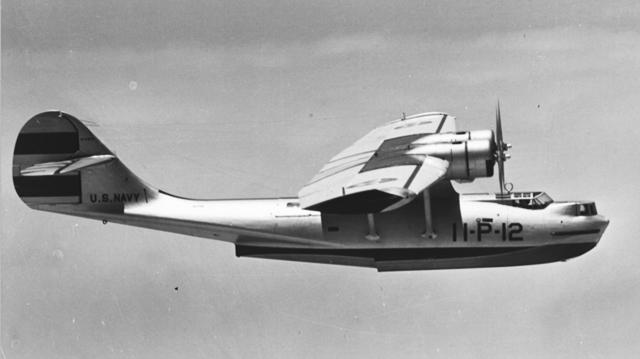
The answer: versatility.
more...
Posted by: Wonderduck at
07:45 PM
| Comments (10)
| Add Comment
Post contains 896 words, total size 6 kb.
1
Good post! Of course, now I'm eagerly awaiting whatever you have to say about the Hornet's after action report.
One of the air museums up here has a Catalina on display. Probably Tillamook, but it might be at Evergreen. It's not as big in person as you'd expect, but then few of the World War II planes are. I remember being amazed the first time I saw a B-17 static display sitting next to an F-15 or maybe an F-14 that was nearly the same size.
I'm now curious to learn how they handled certain inevitable events on a 20 hour mission on this plane and others that had similarly long missions in those days.
Posted by: David at September 19, 2011 09:17 PM (Kn54v)
2
About how you'd expect, David. I suspect the hatches on the dash-4 and before had more than one use.
Posted by: Wonderduck at September 19, 2011 09:33 PM (o45Mg)
3
A PBY had a galley and I'm pretty sure it had a toilet. Just a hole in the hull beneath the seat, of course.
But one of the things that the Dumbo missions used to do when they pulled a man out of the water was to serve him a hot meal.
Posted by: Steven Den Beste at September 19, 2011 11:13 PM (+rSRq)
4
By the way, thank you for this post. It's very good.
Posted by: Steven Den Beste at September 19, 2011 11:22 PM (+rSRq)
5
I found plenty of references to the galley... heck, TIME did an article on the "PBY Dumbo" back in 1945 that featured a lovely photo of a sailor "making breakfast for his crew"... but I couldn't find a picture of the head arrangements to save my life.
Except in modern PBYs... there's one flying out of Durban that has a full bathroom (minus tub/shower) with a standard-looking commode.
I'm sure you're right, Steven, about the hole, except... well, flying boat. Maybe they just went into the bilge.
Posted by: Wonderduck at September 19, 2011 11:57 PM (o45Mg)
6
Thanks, brother. The Cat has always been near and dear to my heart (I just LOVE butt-ugly aircraft!) - and the thought of paintin' one black and hangin' lousy-operating torps off it to hunt Nips at night freezes the marrow in my bones. Do you know anywhere I could buy a ride? Already have notched a Ford Trimotor, T-6, and B-17...
Now tell the story about Ring. Swede Larsen already seems to have been a perfect rectum - and I'd like to see how Stanhope measures up to him. Looking forward to your next posting.
Posted by: The Old Man at September 20, 2011 12:47 PM (TcNy+)
7
Reading the post about the PBY (For those who do not know, 'Catalina' was the name the British gave the PBY when they started to receive them. Unlike the Martlet, it stuck with the Americans.), I was reminded of one of the odder little tales to come out of the WW2, namely of the Dutch PBYs that spent time as part of Midway's aircraft complement following Pearl Harbor. And it was a PBY of the Royal Canadian Air Force which located the Kido Butai when the Japanese started their first Indian Ocean Raid.
The Australian also used the PBY as airborne minelayer in the Solomons, New Guinea, and South-East Asia, as well as a covert transport for supply coastwatchers and other parties behind enemy lines.
C.T.
Posted by: cxt217 at September 20, 2011 02:32 PM (D0JxA)
8
The British are responsible for a lot of the names we hold near and dear. They named the Mustang, for example. They were the ones that named most of our tanks e.g. Sherman, Sheridan, Grant, Lee.
That's because the US Army wasn't into those kinds of names early in the war. The US Navy was, though, and it was Americans that chose names like Hellcat and Corsair.
Posted by: Steven Den Beste at September 20, 2011 06:59 PM (+rSRq)
9
I didn't know that they had named the tanks too. And really, Lee? That's... possibly not 100% politic, no? It'd be like supplying a tank to Soviet Russia and calling it the Czar...
Posted by: Avatar_exADV at September 20, 2011 07:57 PM (pWQz4)
10
I do not believe the British ever used 'Sheridan' as the name of a tank. They used 'Stuart' though, for the M3 light tanks.
As for whether it was politic - the US Army had already named some bases after Confederate officers (Fort Bragg comes to mind.), so why not name a tank after the one of the best?
The US Navy was obviously different from the US Army in giving names, though it seemed to have adopted names a bit (Catalina, obviously, and IIRC, 'Helldiver' for the SB2C was suggested by the manufacturer.).
And related to what Wonderduck commented - as much as Stanhope Ring's performance left much to be desired at Midway, I would add Marc Mitscher as another officer who fell short. The main difference between Mitscher and Ring was that Mitscher received a better reputation.
Posted by: cxt217 at September 20, 2011 09:09 PM (D0JxA)
Hide Comments
| Add Comment
August 24, 2011
Harry's Life
There are times that I hate blogging. Trying to come up with interesting posts, spending the time to bring them to fruition, then realizing that it was an "eh" idea in the first place. Then there are the days that you can't come up with anything good at all, and you resort to posting pictures of rubber duckies or cartoon girls or music videos. There are days where you just feel like chucking it all and walking away.
And then there's days like today, when the perfect idea for a story falls into your lap. Like this one, which I'll call "Harry's Life."
Harry lived and worked in India before The War To End All Wars. A newspaper reporter, he surely could smell the coming conflict, but he was of the age where one has no fear of one's own mortality. It could never happen to you, it would always happen to the other guy. Once the Great Mistake (pt 1) began, Harry didn't give staying out of the fray a second thought.
Harry was never a tall man. He did have the air of the rake about him, however, with hair that Clark Gable could only envy. He occasionally grew a dapper mustache, but it never stayed around for long. His eyes had the cool, appraising look that were the mark of a good newspaperman. In truth, he didn't look the part of a soldier but when War began, he immediately enlisted with the nearest British regiment... well, almost. Instead, he joined the Ghurkas.
"If a man says he is not afraid of dying, he is either lying or a Ghurka." This quote, from Field Marshal Manekshaw, tells you all that you need to know about the fighting spirit of these legendary soldiers. Amongst them, Harry felt at home. He learned and truly understood the war cry of the Ghurkas, "Jai Mahakali, Ayo Gorkhali!", which translates to "Glory be to the Goddess of War, here come the Ghurkas!" When his regiment was called to France, Harry went along... to the Battle of Loos.
In a war full of mass casualties for little gain, Loos would barely rate a mention... if it wasn't for the futility of it all. Ammunition shortages limited the pre-attack artillery bombardment. The British used poison gas for the first time, releasing 140 tons of chlorine gas... much of which was blown back over their own lines. Then, at 0630 on September 29th, 1915, six divisions of troops charged out of their trenches... into the face of German machinegunners unfazed by the weak bombardment. As they charged across the open plain between the trenchlines, the Ghurkas discovered that much of the German barbed wire was still in place, unsevered by artillery. Undaunted, Harry found himself in the forefront of his company's charge into the enemy trenches. With kukri and grenade, he helped cause one of the first substantial breakthroughs of the war, leading to the taking of the town of Loos. Three days later, the Germans counterattacked and threw the British back to their lines. Over 20000 men lay wounded or dead after three days of stiff fighting. Harry was one of them, the victim of a German artillery shell.
Riddled with shrapnel, he was invalided to England to recuperate. While there, his Regiment of Ghurkas, used up by battle, was sent back to India, surely kicking and screaming. However, Harry wasn't done with France yet. Once up and around, he joined The Duke of Cambridge's Own Middlesex Regiment and returned to the trenches. Except this time around, he was an oddity. His kukri by his side, he knew his ways around the muddy passages and the fields of death around him. His experience made him valuable to his company, and he quickly became a trusted squad leader. One dark night, he led a handpicked team across no-man's land, returning with prisoners and intelligence. This brazen mission earned him a mention in the regimental dispatches... and a Croix de Guerre with bronze star. He only just was told of this honor when his old nemesis, the German artillery shell, found him again and left him with a bellyful of shrapnel. And back to England he was sent once again, back to hospital.
While there, he caught the eye of a pretty nurse. Certainly there wasn't a whole lot he could do with his abdomen wrapped in bandages, but his good looks and witty repartee certainly stood out amongst the other soldiers there. In some ways, leaving hospital was one of the tougher things he'd ever done... after all, he was leaving the pretty nurse behind. Much to his surprise and delight, she made sure he knew how and where to reach her when he could. For once again, the warrior in Harry sent him back into the fray. But this time, he would make sure that the German artillery could not get him.
As early as his time at Loos, Harry would look up and see the birds of the Royal Flying Corps soaring high above him and marvel at their grace and serenity. During his second recuperation, he petitioned for a transfer to the RFC, and to everybody's amazement, he was accepted. Perhaps 'Bloody April' had something to do with it. In any case, Harry found himself posted to RAF Station Marham, flying the Sopwith 1-1/2 Strutter. Perhaps unsurprisingly, he tended to fly the way a Ghurka fights... take no prisoners and all-out, nearly in a frenzy. Also perhaps unsurprisingly, in 1917 he somehow managed to make his bus fall eight hundred feet out of the sky and into a cabbage field. The result looked something like this...
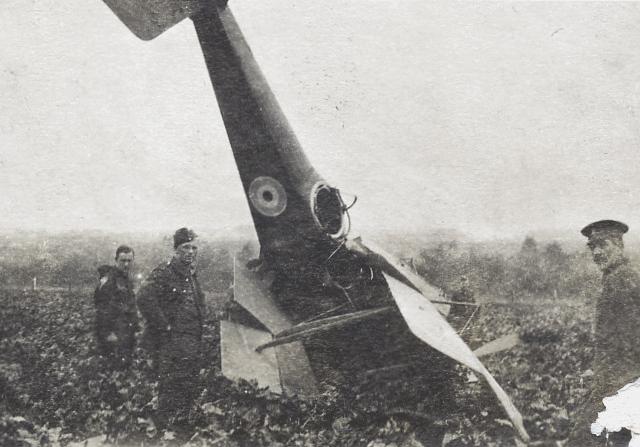
His training set back by the injuries sustained by this wreck, he only managed to fly a few milk-run missions over France before the war came to an end. One would think that'd be the end of the tale of Harry's life, but in some ways the best was yet to come.
After the war, Harry tracked down the pretty nurse, courted her and eventually married her. Amongst other things, he somehow eneded up working for St Dunstan's, the UK's national charity for ex-servicemen that had suffered blindness due to the war. There, he taught various vocational skills and discovered that he himself had a hidden skill at laquerwork. Late in his life, Her Majesty Queen Elizabeth II came to St Dunstan's, where he presented her with one of his laquerwork trays in celebration of her visit. It was one of the high points of a busy, and unique, life.
A wonderful story, and I'm glad I came up with it... except I left out two details which make it even more amazing:
more...
Posted by: Wonderduck at
10:56 PM
| Comments (2)
| Add Comment
Post contains 1351 words, total size 8 kb.
1
God BLESS it, I love the way your mind picks out subjects to write about..... Now where's that article about Black Cats in the Pac Theatre? (grin)
Keep up the good work - don't let the undergrad ducklings mess with your mojo...
Posted by: The Old Man at August 25, 2011 09:46 AM (TcNy+)
2
Well done!
Alas, All I came here to give you was a link to a Music Video with a Cartoon Girl and a Rubber Duckie.
http://www.youtube.com/watch?v=u1E_LgLaiRE
Which I found here in this article about an innovative 3-D display device in Japan.
http://blogs.wsj.com/japanrealtime/2011/06/22/hatsune-miku-larger-than-life-5-centimeters-tall/
Posted by: Mauser at August 26, 2011 02:43 PM (cZPoz)
Hide Comments
| Add Comment
August 14, 2011
August 14, 1945
66 years ago today, Japan surrendered to the Allies, thus bringing an end to World War II. The official ceremony wasn't conducted until September 2nd, and that's the day that we celebrate here in the US as the end of hostilities, August 14th was the date that the the announcement was made to the Japanese people. August 14th was also the date the second-most famous photograph from the Pacific War was taken.
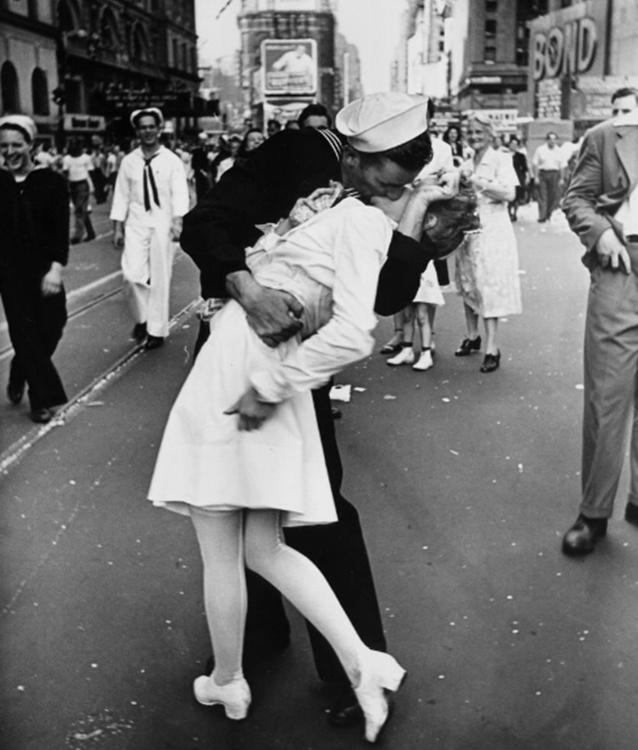
I wonder what the following 19 days were like for those on the front lines of the war. Hostilities had ended, but it wasn't official yet... and surely nobody wanted to be the last casualty of WWII.
Posted by: Wonderduck at
09:18 PM
| Comments (6)
| Add Comment
Post contains 112 words, total size 1 kb.
1
Nobody on
our side. A not-insignificant portion of the Japanese high command committed suicide. One of them declared his intention to "live on in the noble spirit of the special attack" (think I'm quoting that right, anyway), hopped in a plane, and headed east, never to be heard from again. Certainly he didn't hit anyone.
The Japanese were pretty worried that some other hothead would decide to do something similar to MacArthur's fleet when it arrived. They went so far as to take all the propellers off the planes to prevent any last-minute stupidity.
Posted by: Avatar_exADV at August 15, 2011 01:55 AM (j42B4)
2
Or Halsey's fleet, anyway. (MacArthur was Army...)
Posted by: Steven Den Beste at August 15, 2011 07:45 AM (+rSRq)
3
Not my phrase, was the one they used in
Downfall. Granted that of course he was army and not in direct command of the naval vessels, but he was the one who'd been instructed to accept the surrender and to head up the occupation. And for all his many failings as a general, I don't know that we could have found a better man for that role.
Posted by: Avatar_exADV at August 15, 2011 12:01 PM (j42B4)
4
Sadly, it was a fairly insignificant number of the Japanese high command who decided to die with honor - Dr. Edward Drea records that out of 1500 IJA generals, only 22 committed suicide. My read on the proportion of suicides in the IJN is fairly similar. Too many of the rest were trying to destroy documents, or following the example of the Japanese foreign minister, trying to use the dropping of the atomic bombs to divert attention from Japanese atrocities and war crimes against Allied POWs and civilians (Allied and Asians.).
Some of them probably had second thoughts about not taking the honorably way out when it was their turn to face the hangman later on (Like the Japanese admiral commanding the Wake Island garrison, who found his attempt at covering up his war crimes to have failed utterly.).
Posted by: cxt217 at August 15, 2011 01:26 PM (ob/3N)
5
Sorry, Avatar, but MacArthur is a sore spot for me.
MacArthur had the same virtues and flaws as Patton and Montgomery. All of them really were great battlefield commanders. All of them were charismatic, great leaders of men.
And all of them were deeply flawed because of their towering egos. You compare them to men who didn't have that kind of ego problems, like Nimitz and Bradley, and you can see that it wasn't an essential part of the makeup of great leaders.
MacArthur's ego made him do stupid things. It ultimately led to him being relieved in Korea by Truman, and if anything Truman was preternaturally patient with the man and put that off. (And Ridgway, who took over, actually fought a smarter and more effective war than MacArthur had.)
His campaign in New Guinea was by all accounts brilliant, considering his terrible logistics and the beastly conditions, and in fact the ground operations during the reconquest of Luzon etc were brilliant, too. But the man simply wouldn't keep his mouth shut.
And I have to give him credit for his performance during the post-war occupation of Japan. There were so many things he did well; but his flaws and his mistakes just stick in my craw.
Referring to it as "MacArthur's fleet" seems typical, because MacArthur was a glory hound and it would have been in character for him to take credit for that.
Posted by: Steven Den Beste at August 15, 2011 04:18 PM (+rSRq)
6
Don't get me wrong, I'm no more of a Mac lover than you are. I don't even really give him the credit for generalship. The histories I've read generally credit him for bungling the defense of the Philippines (not that they expected him to hold it, to be sure, but his defensive plans ensured that most of the troops ended up in Bataan with most of the supplies outside it, and were responsible for a good amount of the misery the soldiers suffered.) They weren't any kinder to him when it came to the crossing of the Owen Stanley range ("reminiscent of the worst generalship of the First World War", one wrote).
I'll grant that he knew how to use amphibious landings to his advantage. But his actual generalship wasn't any better than indifferent, at least not until later in the war, by which point he was facing isolated Japanese outposts that he could bypass when necessary. And his political interference simply had no place in the proper conduct of an officer. There's also the matter of all that Filipino money that he ended up with...
Shoot, now I wanna do a MacArthur post.
Posted by: Avatar_exADV at August 15, 2011 10:05 PM (pWQz4)
Hide Comments
| Add Comment
August 09, 2011
The Muroc Maru
Over the years, practice targets have taken many forms. Watermelons, poles stuck in the ground, human silhouettes, bulls-eyes, "black dots," on and on. One of the most...
unique... was finished in 1943.
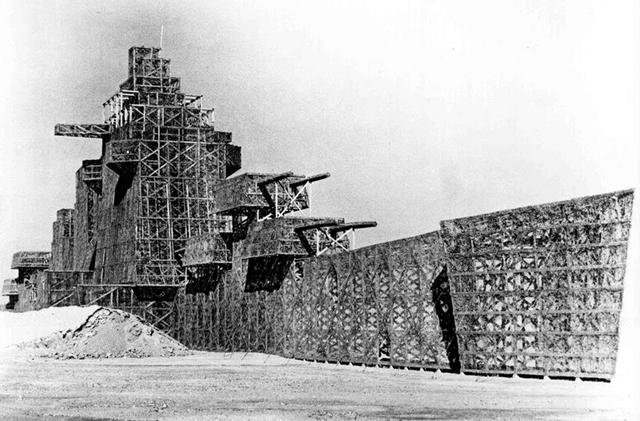
Army Air Forces Temporary Building (Target) T-799, dubbed the "Muroc Maru", was constructed on the grounds of Muroc AAF Base for the then princely sum of $35000. Built out of 4x4 lumber and chicken wire, then covered with tar paper and liberally coated with ground-up chicken feathers, it was the spitting image of an Imperial Japanese Navy
Takao-class heavy cruiser. Sand berms were added to give the appearance of a wake.
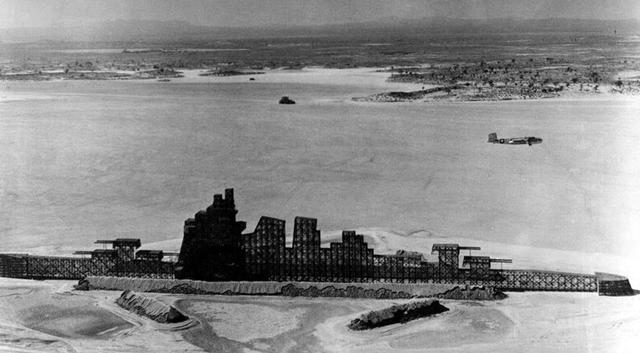
Probably the largest single-structure target ever built at 650 feet long, the Muroc Maru was used for identification training, strafing and skip-bombing practice. Unfortunately, the chicken feathers could not hold up to the hot winds and .50cal slugs and usually disintegrated or blew away.
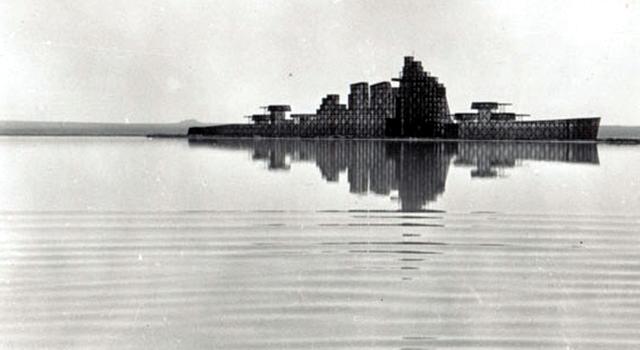
Built at one end of Rogers Dry Lake on the Muroc base complex, it often gave pilots the impression of movement from heat distortion coming off the lakebed. It also caused some consternation amongst drivers passing by to the north, to whom it looked exactly like a ship sailing in the desert.
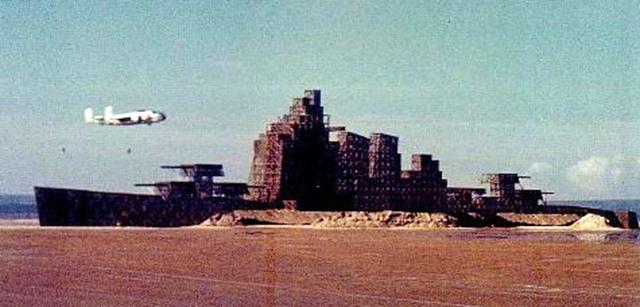
The Muroc Maru stayed in position until 1950, when it was declared a flight hazard and taken down (sunk?). Reportedly the Army engineers had quite the time of it from all the unexploded ordinance in the vicinity. All that remains today are a few tons worth of nails and staples and some sand berms.
Posted by: Wonderduck at
06:40 PM
| Comments (5)
| Add Comment
Post contains 256 words, total size 2 kb.
1
I love the pic of the Mitchell behind it. Wonder if it was set up with all the .50s for strafing....
(To mis-quote the Joker) "Where do you get all the marvelous pictures??
Posted by: The Old Man at August 10, 2011 01:20 PM (TcNy+)
2
T.O.M., a lot of the time finding the "marvelous pictures" are just luck. For example, I first saw a pic of the Muroc Maru while doing research for my
USS Wasp post, and said "that's cool, I'll remember that." Over a year later,
World War II magazine used the same photo (the color one) in one of their contests, which rekindled my interest in the topic. So I went digging and found the others.
Usually there's a lot of googling involved. I've already put in a solid three hours on the upcoming PBY post, looking for suitable pics. Sometimes, they're only available in a book... at which point I break out my trusty camera.
So it goes.
Posted by: Wonderduck at August 11, 2011 10:01 PM (KBBJ+)
3
I think the Starblazers are going to have trouble turning that into a starship.
Posted by: Maureen at August 11, 2011 10:39 PM (BB7+i)
4
Space Target Muroc Maru!
Posted by: Wonderduck at August 12, 2011 06:58 AM (KBBJ+)
5
Seeing photos of the Muroc Maru reminds me of all the cool, weird, and just-plain-strike-your-fancy photos from WW2 I remembered over the years. Other than the obvious one (The Flag of Suribachi.), the one that immediately comes to mind is the photos taken aboard the ZUIKAKU just before her crew started going over the side at Cape Engano. I am sure other people have other photos that come to mind.
C.T.
Posted by: cxt217 at August 12, 2011 12:15 PM (obaoh)
Hide Comments
| Add Comment
197kb generated in CPU 0.0604, elapsed 0.1728 seconds.
63 queries taking 0.1305 seconds, 402 records returned.
Powered by Minx 1.1.6c-pink.
 my military history books out of my bedroom and into one of the big bookshelves in the living room... well, here was my chance!
my military history books out of my bedroom and into one of the big bookshelves in the living room... well, here was my chance! 






